Samsung Electronics Co AARR1D9TG Wireless Dongle User Manual 11 AA KR1D9TG
Samsung Electronics Co Ltd Wireless Dongle 11 AA KR1D9TG
User Manual_AA-RR1D9TG

www.samsung.com
User Manual
2
Getting started
3 About this manual
7 Layout
12 Turning the computer on
and off
14 Unlocking the screen
14 Windows
Basics
17 Wired keyboard/mouse
(optional)
19 Wireless keyboard/mouse
(optional)
26 Memory card
29 External display
30 Using the LCD as an
external monitor
(optional)
31 Playing music from a
mobile device through
the computer’s speakers
(optional)
34 Wired LAN
37 Wireless LAN
38 Using the Security slot
Applications
39 Using applications
40 Samsung Settings
41 Samsung Update
42 Online Support (S Service)
43 Samsung PC Help
(Self-help application)
Settings & Upgrade
44 LCD brightness
45 Volume
46 BIOS (Setup utility)
Troubleshooting
51 Samsung Recovery
57 Windows recovery
function
57 Q&A
Appendix
60 Product specifications
61 Ergonomic tips
65 Safety precautions
73 Important safety
information
76 Replacement parts and
accessories
79 Regulatory compliance
statements
89 WEEE symbol information
91 Samsung package Take-
Back program
Table of contents
3
Getting started
About this manual
r
This user manual is specially designed to detail the computer’s
functions and features.
r
The user manual supplied with the computer may vary
depending on the model.
r
Please read this manual before using the computer to ensure
safe and proper use.
r
Optional accessories, some devices, and software referred to
in this manual may not be provided or may not be subject to
upgrades. Note that the computer environment referred in
the user manual may not be the same as your environment.
r
Descriptions are based on the computer’s default settings
and the Windows 10 operating system. Available features and
additional services may vary depending on the computer or
operating system.
r
This user manual describes procedures for using the
touchpad, mouse and touch screen. Instructions for using the
touch screen are for models with the touch screen feature.
r
Images and screenshots are those of the representative model
of the series and may differ in appearance from the actual
product.
r
Content may differ from the final product and is subject to
change without prior notice. For the latest version of the
manual, refer to the Samsung website, www.samsung.com.

Getting started
4
Copyright
Copyright © 2016 Samsung Electronics
This manual is protected under international copyright laws.
No part of this manual may be reproduced, distributed, translated,
or transmitted in any form or by any means, electronic or
mechanical, including photocopying, recording, or storing in any
information storage and retrieval system, without the prior written
permission of Samsung Electronics.
Computer specifications or the contents of this manual may
be changed without prior notice due to an upgrade of the
computer’s functions.
Instructional icons and expressions
Warning
: situations that could cause injury to yourself or
others
Caution
: situations that could cause damage to the
computer or other equipment
Note
: notes, usage tips, or additional information
The path you should follow to carry out an instruction. For
example, “select
Settings
ĺ
Devices
” indicates that you
should select
Settings
and then
Devices
.
Select Click the mouse or tap the touchpad or touch screen.
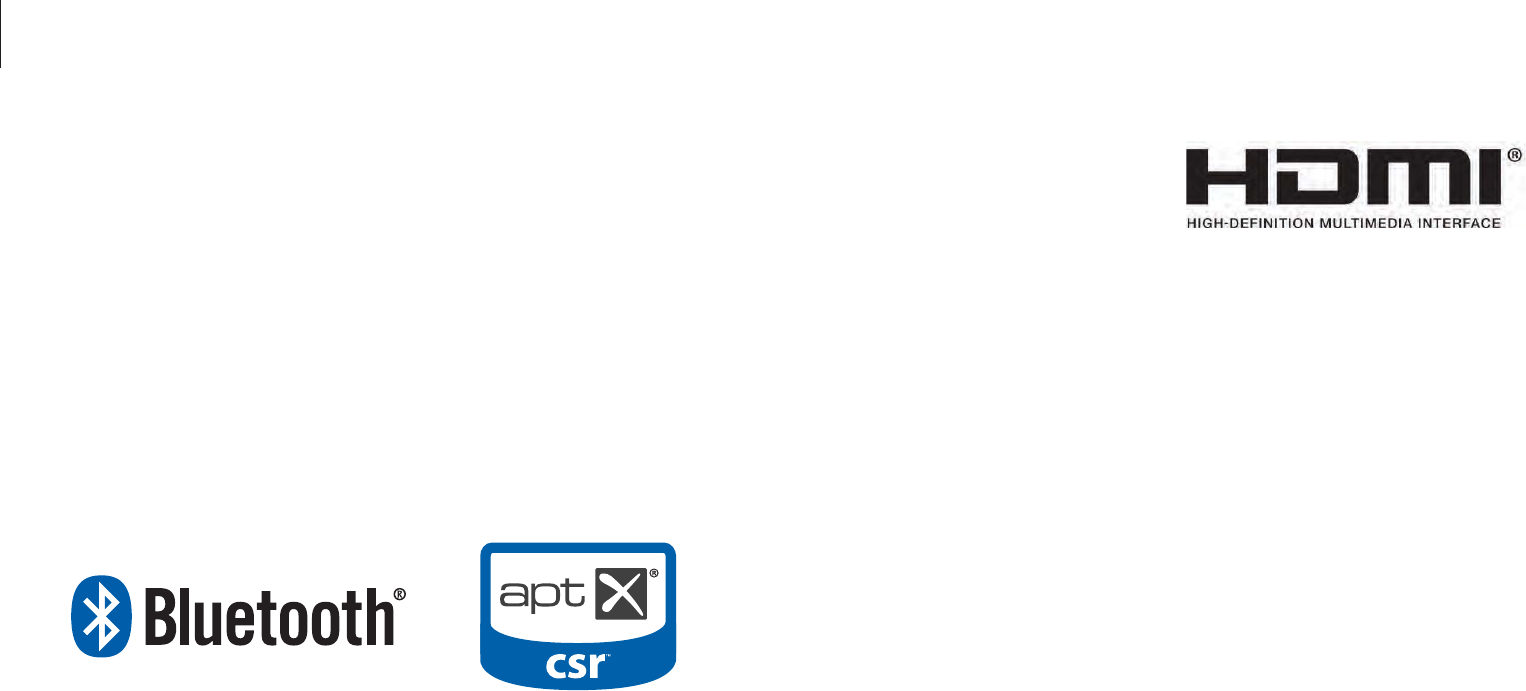
Getting started
5
r
HDMI, the HDMI logo, and
the term High Definition
Multimedia Interface are
trademarks or registered
trademarks of HDMI Licensing
LLC.
r
All other trademarks and copyrights are the property of their
respective owners.
Trademarks
r
Samsung and the Samsung logo are trademarks or registered
trademarks of Samsung Electronics.
r
Intel and Core are trademarks or registered trademarks of the
Intel Corporation.
r
Microsoft, MS-DOS, and Windows are trademarks or registered
trademarks of the Microsoft Corporation.
r
Bluetooth® is a registered trademark of Bluetooth SIG, Inc.
worldwide.
r
Wi-Fi®, Wi-Fi Protected Setup™, Wi-Fi Direct™, Wi-Fi
CERTIFIED™, and the Wi-Fi logo are registered trademarks of
the Wi-Fi Alliance.

Getting started
6
Product capacity representation
Storage capacity representation
The capacity of the storage device (HDD, SSD) of the manufacturer
is calculated assuming that 1 KB = 1,000 Bytes.
However, the operating system (Windows) calculates the storage
device capacity assuming that 1 KB = 1,024 Bytes. Therefore, the
available capacity of the HDD in Windows is smaller than the
actual capacity due to the difference in capacity calculation. For
example, for an 80 GB HDD, Windows calculates the capacity as
74.5 GB, (80x1,000x1,000x1,000) Bytes/(1,024x1,024x1,024) Bytes
= 74.505 GB.
In addition, the capacity representation in Windows may be even
smaller because some programs, such as Samsung Recovery, may
reside in a hidden area of the HDD.
Memory capacity representation
The available memory capacity in Windows is less than the actual
capacity of memory. This is because some memory is required for
regular system operations.
For example, for 1 GB (= 1,024 MB) memory installed, Windows
may report the capacity as 1,022 MB or less.
Data precautions
Samsung Electronics shall not be liable for any data loss. Please
take care to avoid losing any important data and back up your
data to prevent any such data loss.
Operating system and software support
If you change the product’s factory OS (Operating System) to
another OS or if you install software which is not supported by the
product’s original factory OS, you will not receive any technical
support, product exchange or refund, and a fee will be charged
when requesting a service.
Please use your computer with the original factory OS. If you
install an OS other than the factory OS, data may be deleted or the
computer may not start.
Recommended screen resolutions
It is recommended to set the resolution of your display based on
standard Windows settings.
If you set a high resolution, such as QHD+ (3200x1800), it may not
correctly display some applications.
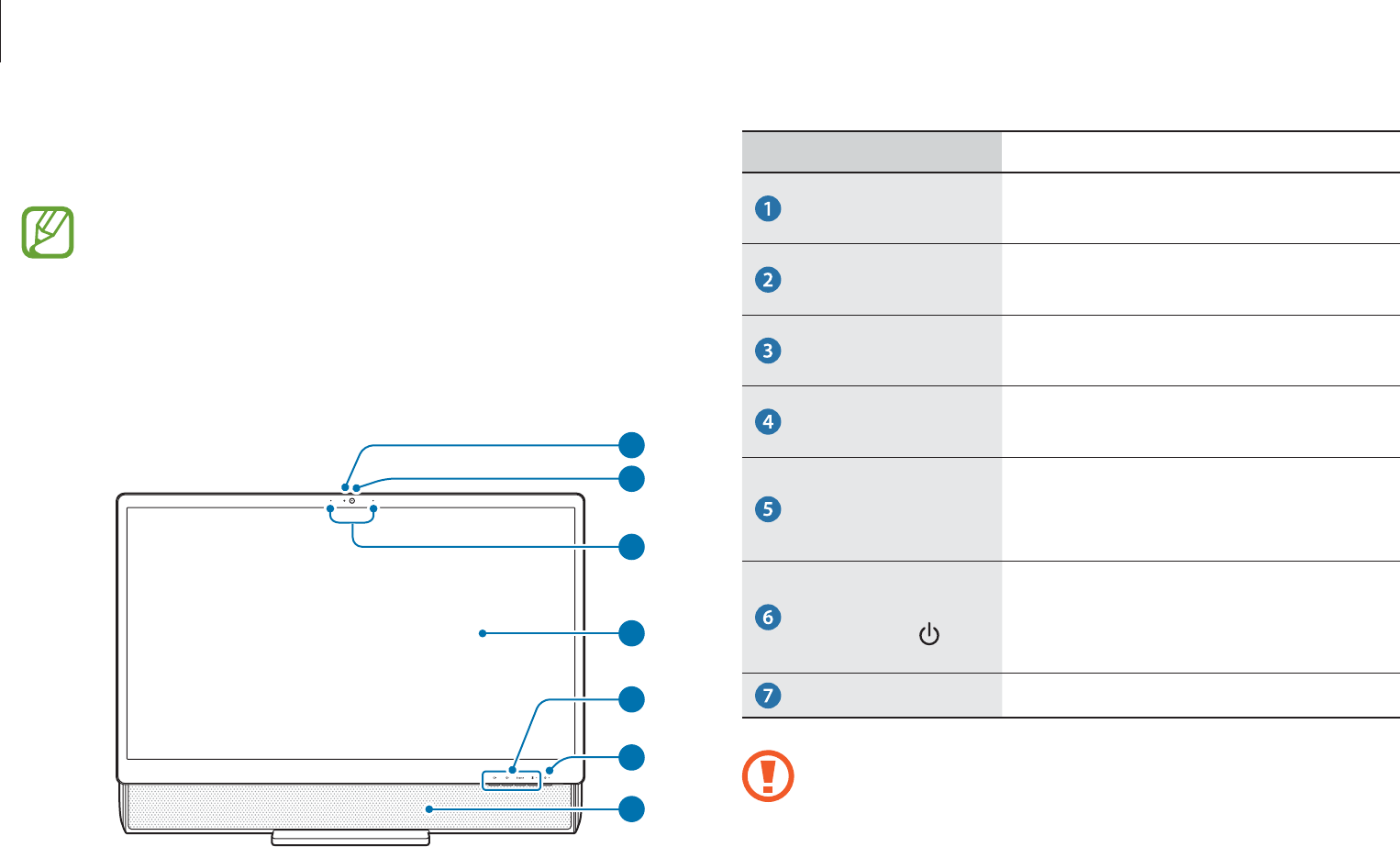
Getting started
7
Number/Name Description
Camera indicator
light
r
This indicates the camera
operating status.
Camera
r
Using this camera, you can take
still pictures and record video.
Microphone
r
You can use the built-in
microphone.
LCD
r
The screen’s images are displayed
here.
Control buttons
(specified models
only)
r
This allows you to adjust various
functions.
Power button/
Power LED
r
Turns the computer on and off.
r
When the computer is on, the
power LED is lit.
Speaker
r
It emits the sound.
r
To change the angle of the LCD screen, hold the side
of the vent and the LCD and tilt it to the desired angle
using both hands.
r
Do not apply downward force to the product when it is
placed face down. Doing so may damage the LCD.
Layout
r
Features or options may differ depending on the model.
r
The items marked as optional may not be provided or
may be provided in different locations.
Front view
1
2
3
4
5
6
7
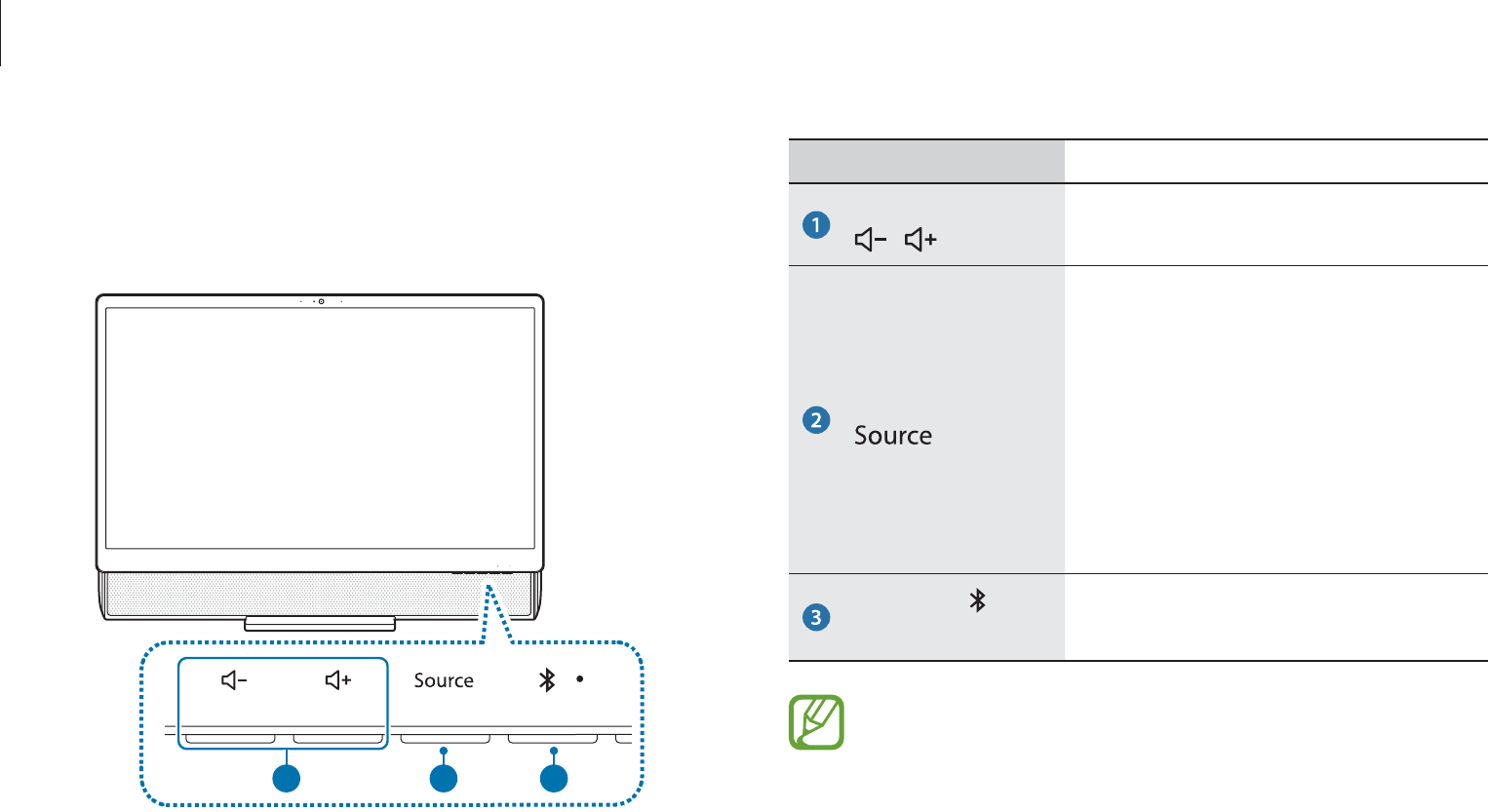
Getting started
8
Number/Name Description
Volume control
/
r
Adjust the volume.
Mode selection
r
Switches between
PC mode
and
Monitor mode
.
–
PC mode
: The computer
operates normally as a
computer.
–
Monitor mode
: The
computer functions as a
monitor.
Bluetooth
(optional)
r
Enable or disable Bluetooth.
Mode selection is used to switch between the PC mode
and the Monitor mode.
Control buttons (specified models only)
Use the buttons at the bottom of the monitor to control various
functions.
2 31
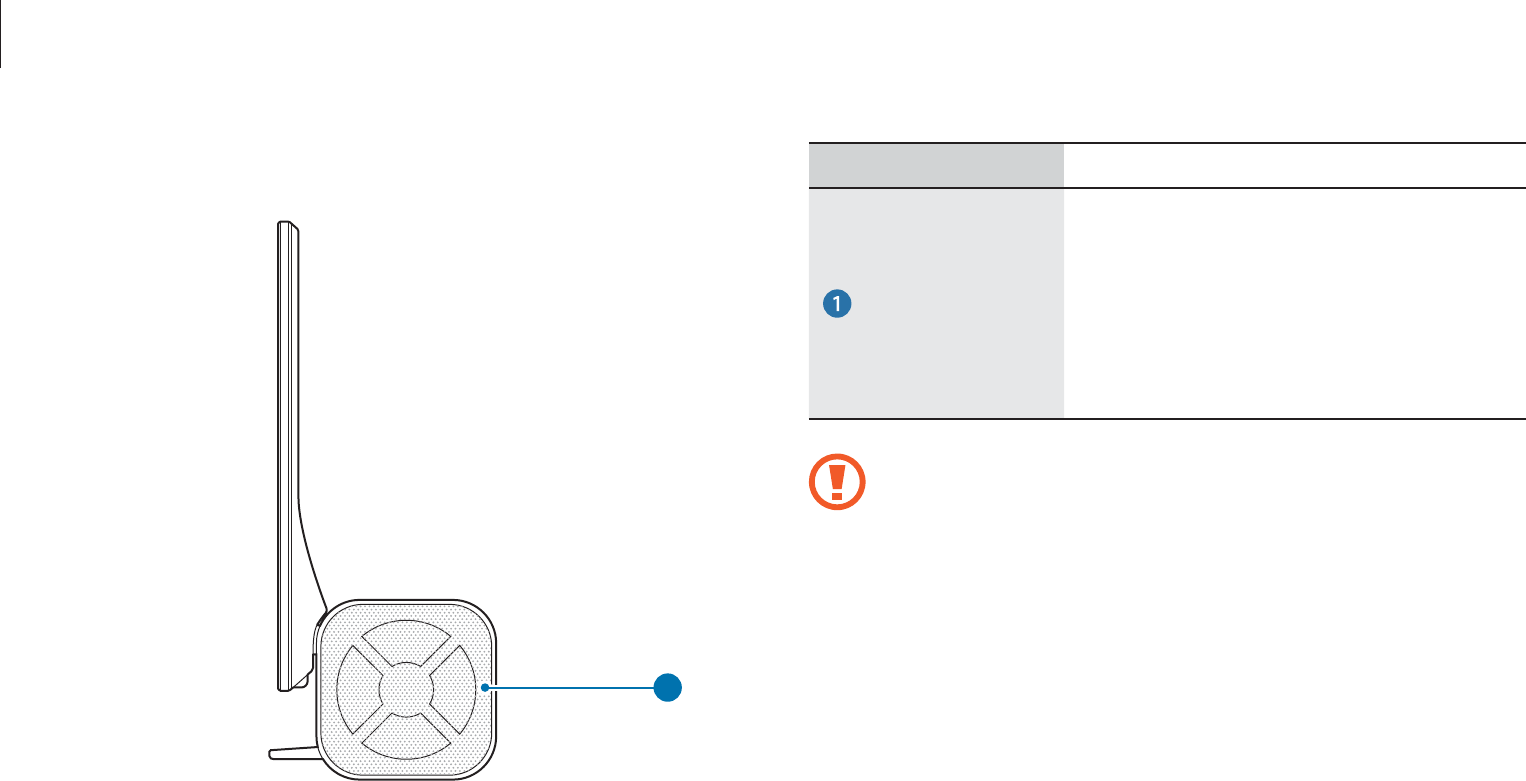
Getting started
9
Number/Name Description
Fan vents
r
The internal heat of the computer is
emitted through these holes.
r
If the vents are blocked the
computer may overheat. Avoid
blocking the vents as this may be
dangerous.
Do not block the vents or it may interfere with heat
release.
Side view
1
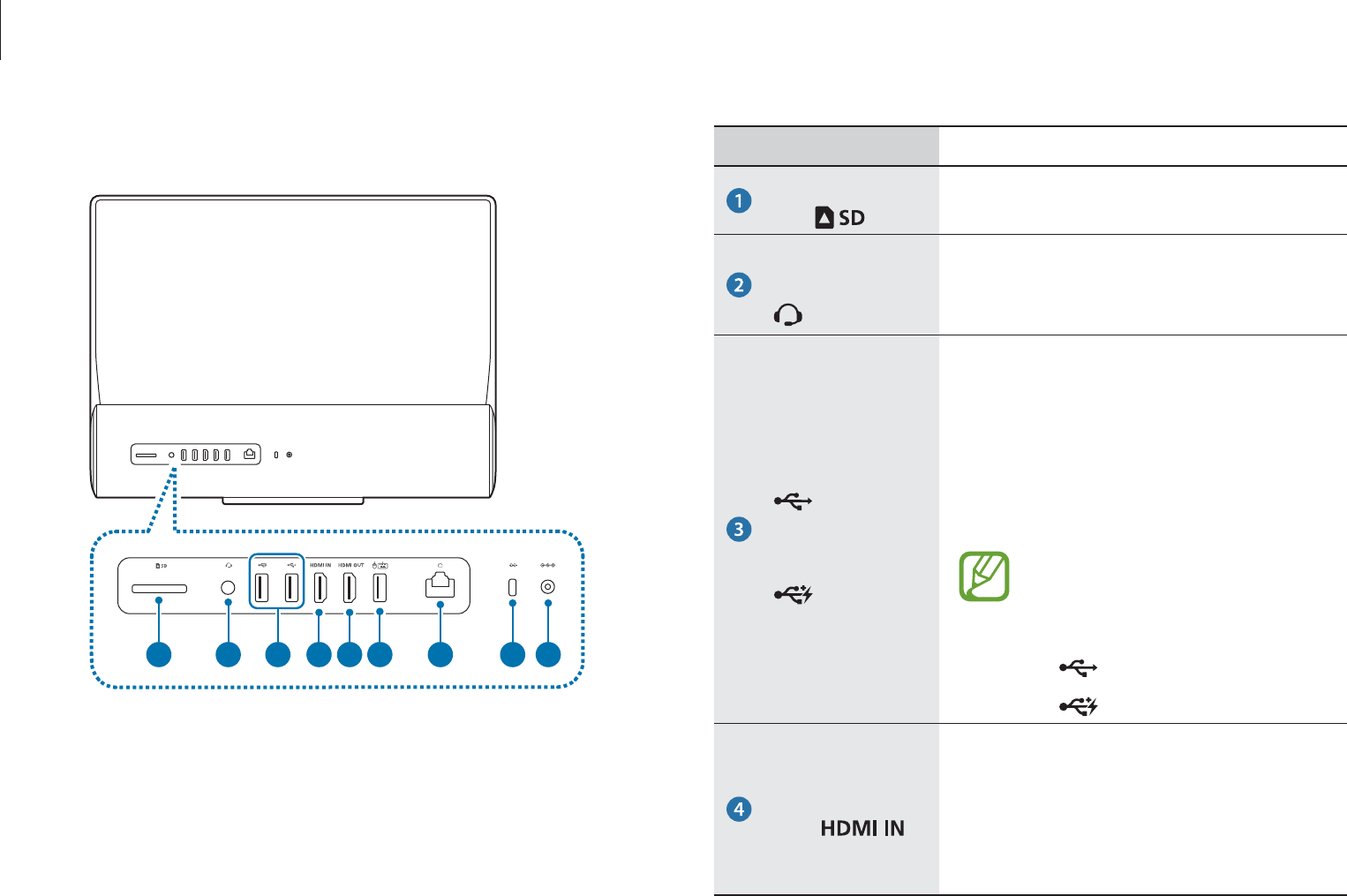
Getting started
10
Number/Name Description
Memory card
slot
r
Insert a memory card into the slot.
Earpiece/
Headset jack
r
Connect an earpiece or a headset to
the computer to listen to audio.
USB 3.0 port
or
chargeable
USB 3.0 port
(optional)
r
USB ports to which you can connect
USB devices as well as a chargeable
USB port are provided.
r
The chargeable USB port can be
used to connect and charge a USB
device.
You can distinguish the ports by
the figures printed on the ports
or by color.
r
: USB port
r
: Chargeable USB port
HDMI input
port
r
Used to connect an HDMI cable from
an external device.
r
Connect to another device via an
HDMI cable to receive its audio and
video on your computer.
Rear view
1 2 4 5 6 7 8 93
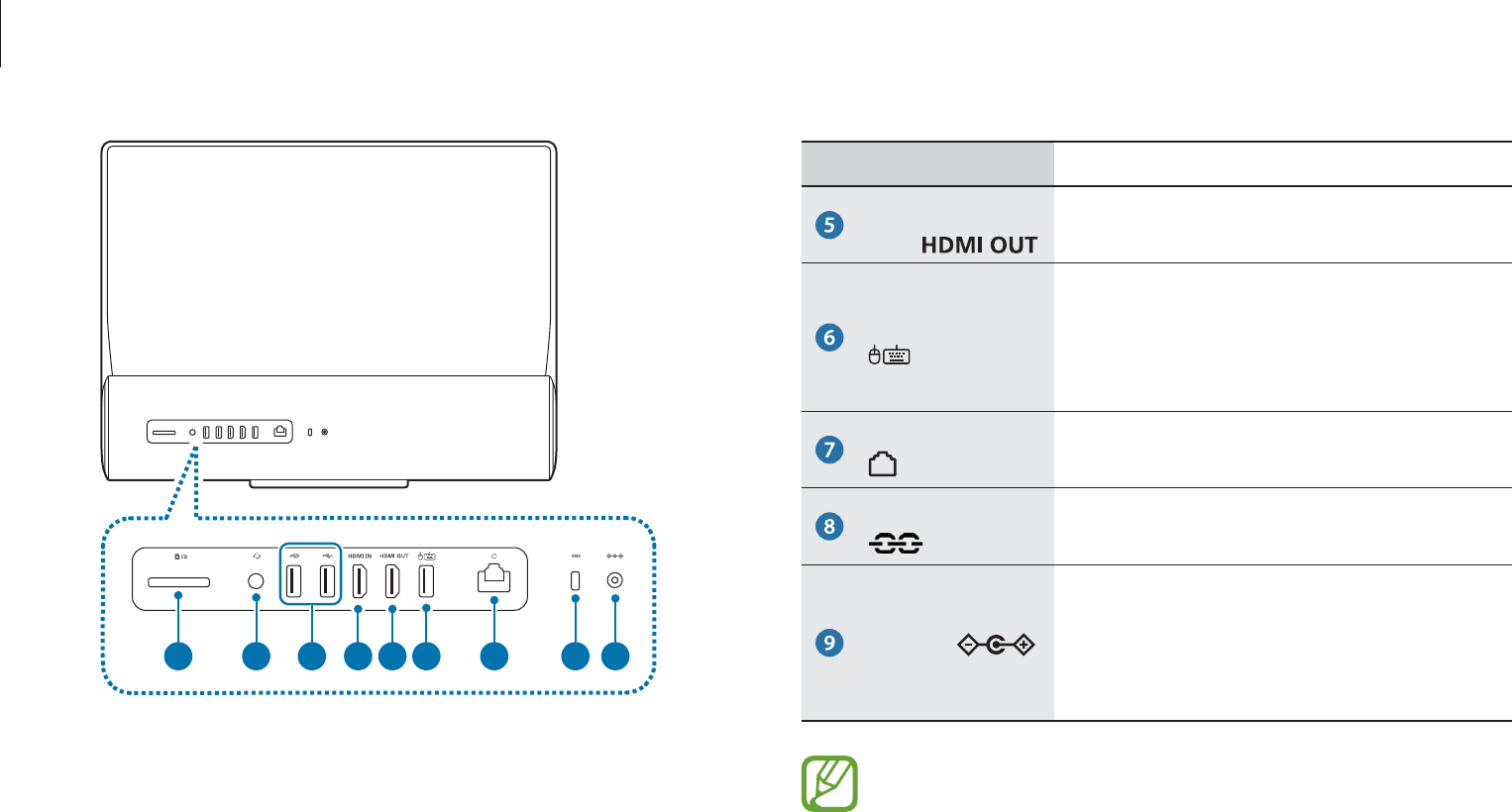
Getting started
11
Number/Name Description
HDMI output
port
r
Used to connect an HDMI cable to
an external device.
USB 2.0 port
r
Connect various USB devices. You
can connect the wireless receiver for
the wireless keyboard and mouse to
this port.
Wired LAN port
r
Connect the Ethernet cable to this
port.
Security slot
r
Secure the computer by connecting
an optional lock and cable to it.
DC jack
r
This jack connects to the AC adapter
to supply power to the computer.
r
The appearance of the jack may
differ depending on the model.
About the chargeable USB port
r
The charging status of the USB device is not displayed
on the computer.
r
This feature may not be available with some USB
devices.
1 2 4 5 6 7 8 93
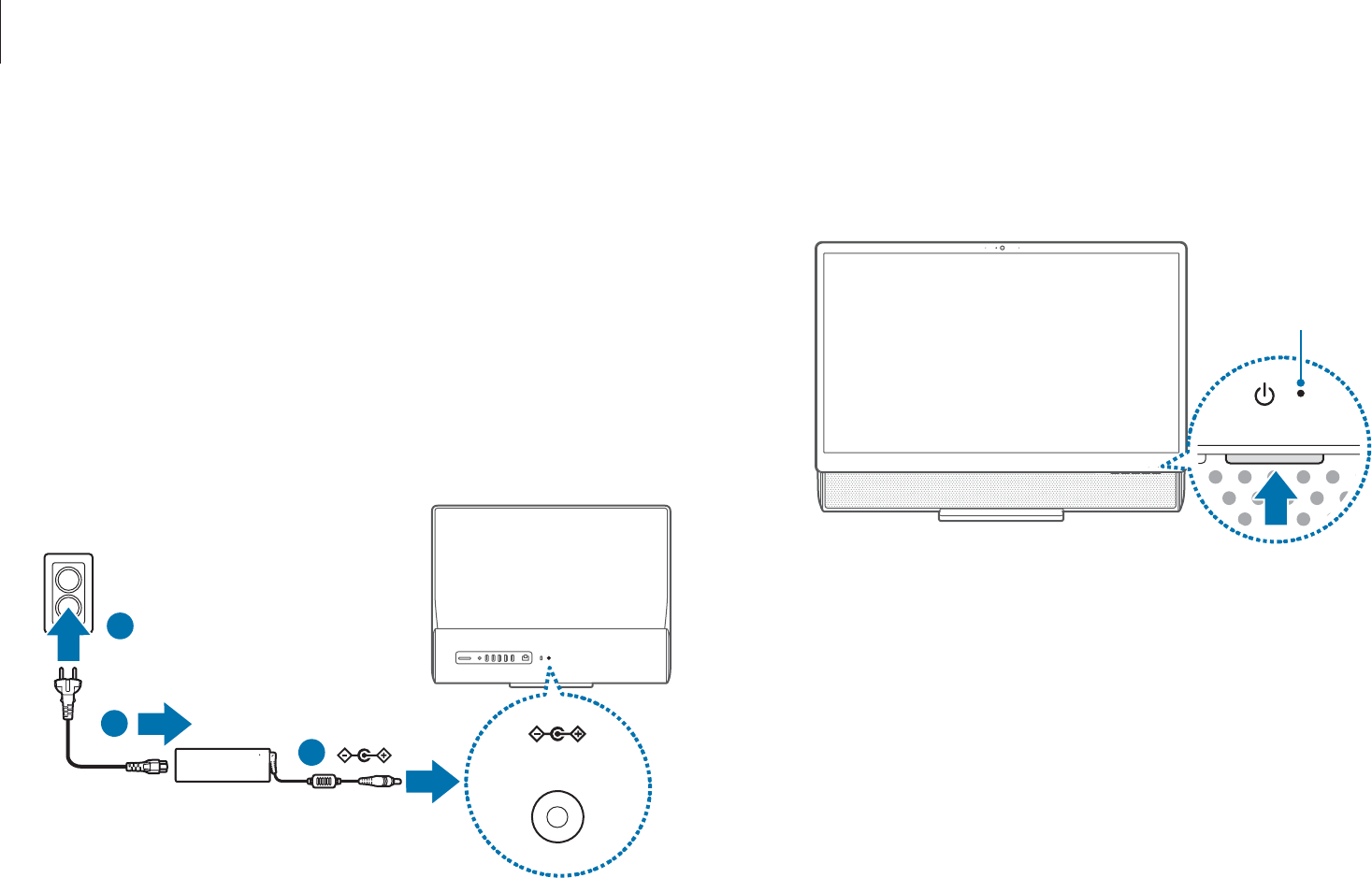
Getting started
12
4Press the Power button to turn the computer on.
While the computer is on, the power LED is lit.
Power LED
Turning the computer on and off
Turning the computer on
1Connect the power cable to the AC adapter.
2Connect the AC adapter to the DC jack of the computer.
3Plug the power cable into an electric socket.
1
3
2
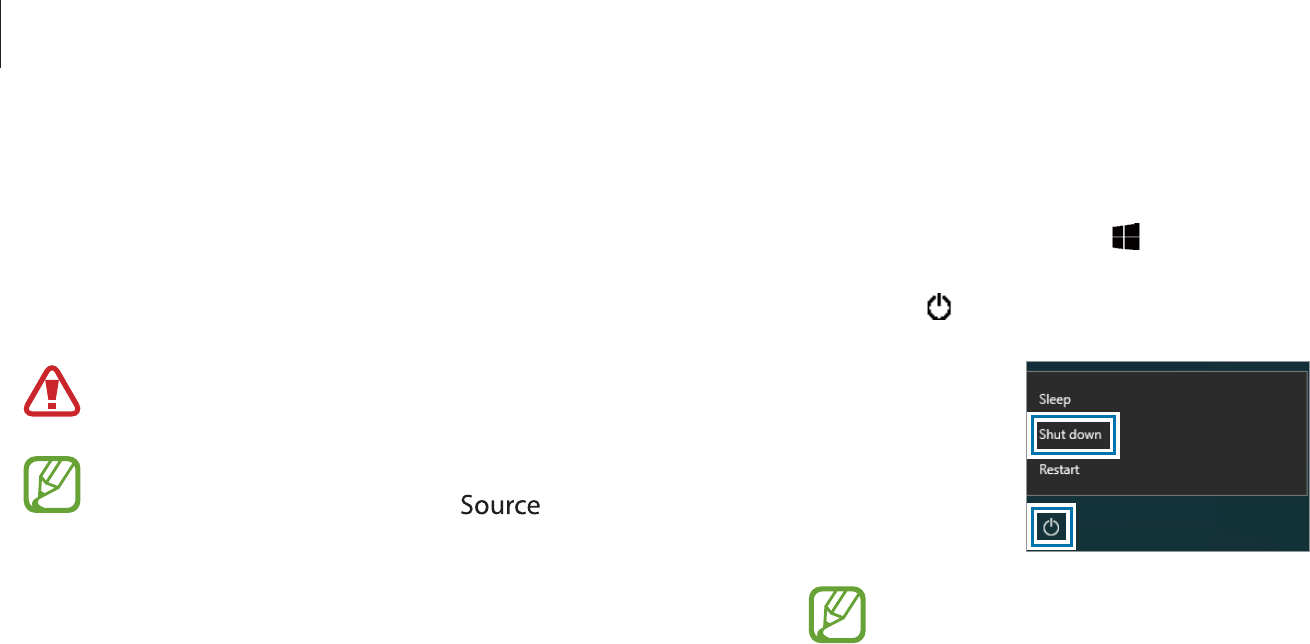
Getting started
13
Turning the computer off
1Select the Start button ( ).
2Select
ĺ
Shut down
.
r
Save all data before turning off the computer.
r
Since the procedures to turn the computer off may
differ depending on the installed operating system,
turn the computer off according to the procedures for
the purchased operating system.
About Windows Activation
When you turn the computer on for the first time, the Windows
activation screen appears.
Follow the activation procedures according to the instructions on
the screen to use the computer.
Do not allow the adapter to make contact with your skin
for a long time. A low temperature burn may result.
After turning on the computer, if the HDMI message
appears on the screen, press the button to change
the screen modes (Monitor mode
ĺ
PC mode).

Getting started
14
Windows
Microsoft Windows is an operating system that is used to control a
computer.
r
Images and available features may differ depending on
the model and operating system.
r
This manual is designed for Windows 10 and content
may differ depending on the OS version.
r
The image displayed on the desktop screen may differ
between models and OS versions.
Help
To access help information, select the Start button ( )
ĺ
Get Started
( ).
You can check the help information after connecting to
the Internet.
Unlocking the screen
To unlock the lock screen, do one of the following:
r
Mouse
: Click the lock screen.
r
Keyboard
: Press any key.
If the account has a password, enter the password to log in after
unlocking the screen.
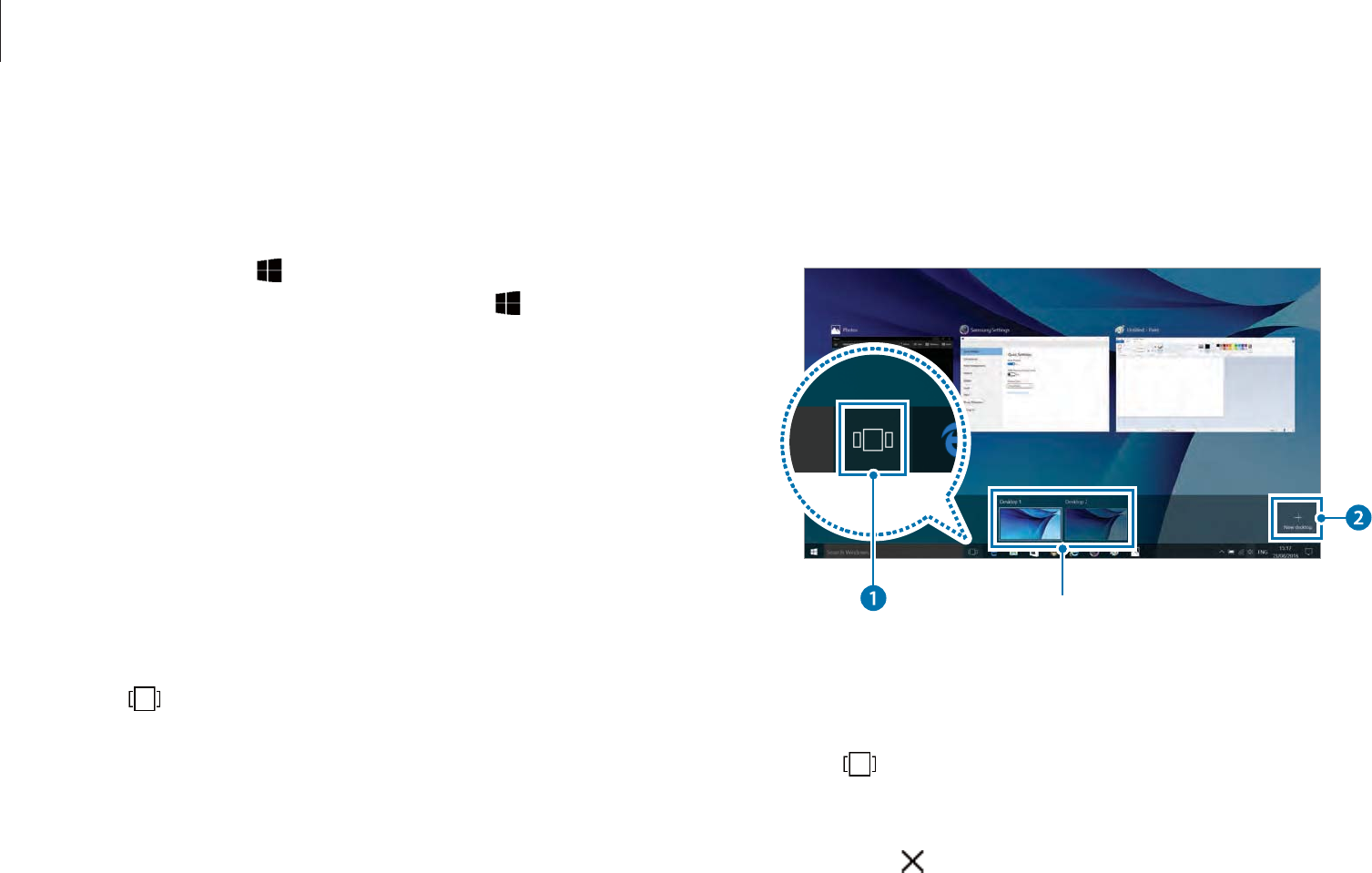
Getting started
15
2Select
New desktop
.
A new desktop will be added. You can select a desktop from
the list displayed at the bottom of the screen.
Multi desktop list
Deleting a desktop
1Select on the taskbar.
2Move the cursor over the desktop icon you want to delete.
Then, select in the upper-right corner of the icon.
Using the control panel
You can adjust basic system settings, such as hardware, software,
or user account settings.
Select the Start button ( )
ĺ
Windows System
ĺ
Control
Panel
. Alternatively, right-click the Start button ( ) and select
Control Panel
.
Then, select options you want to change.
Using a multi desktop
Multi desktop allows you to work on various tasks at the same
time via multiple desktops. You can use different desktops for
various purposes.
Creating a new desktop
1Select on the taskbar.
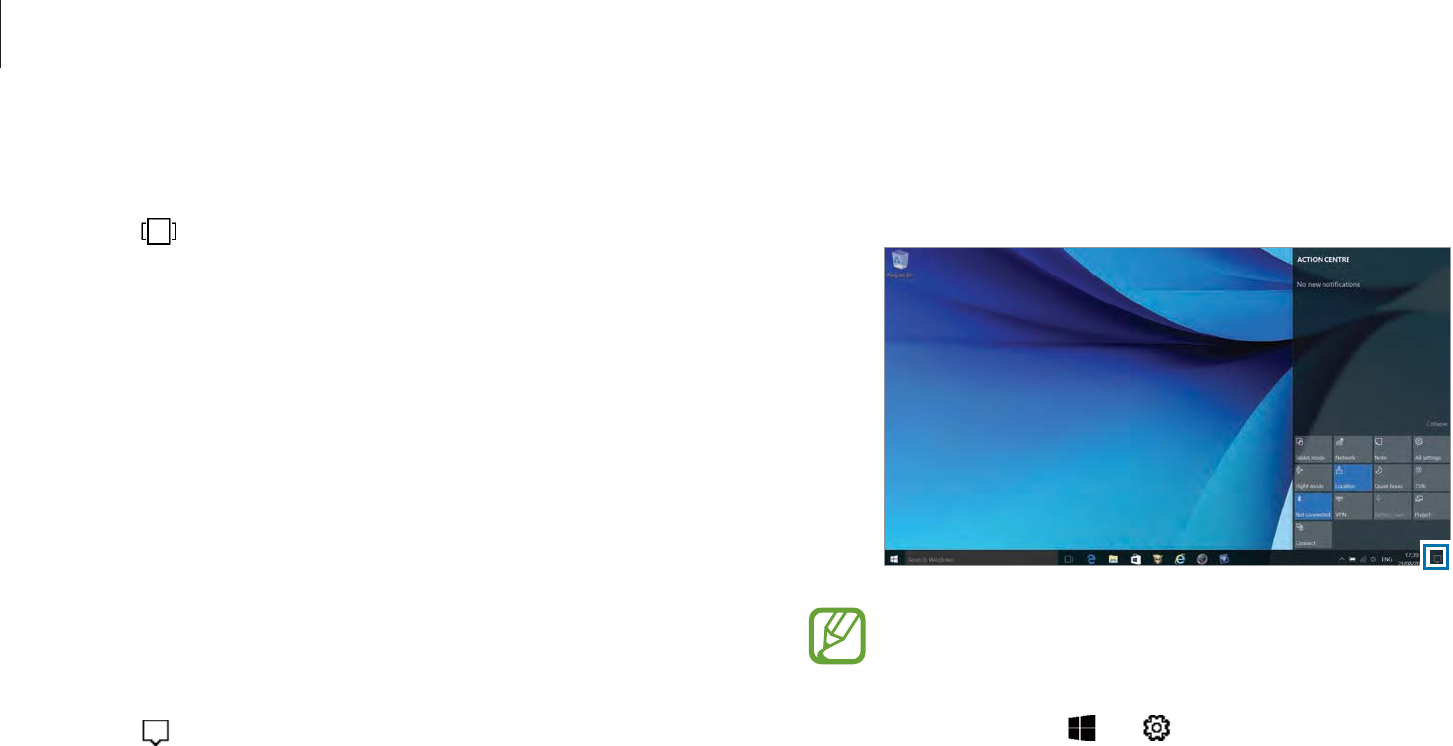
Getting started
16
2When the action center panel appears, select a message to
check it.
r
You can enable or disable push notifications for
applications. You can also set personalized hot keys to
appear in the action center by selecting the
Start button ( )
ĺ
ĺ
System
ĺ
Notifications &
actions
.
r
Select
Expand
or
Collapse
to expand or minimize the
action center menu and select the feature you want to
use.
Moving a program to another desktop
1Select on the taskbar.
2Select a program or window you want to move.
Action Center
The Windows 10 action center allows you to receive system
notifications, such as updates, and push notifications, such as
emails and SNS updates. You can also adjust settings conveniently.
For example, you can select wireless network options or adjust the
volume and screen brightness via hot keys in the action center.
Checking notifications
1Select on the taskbar.
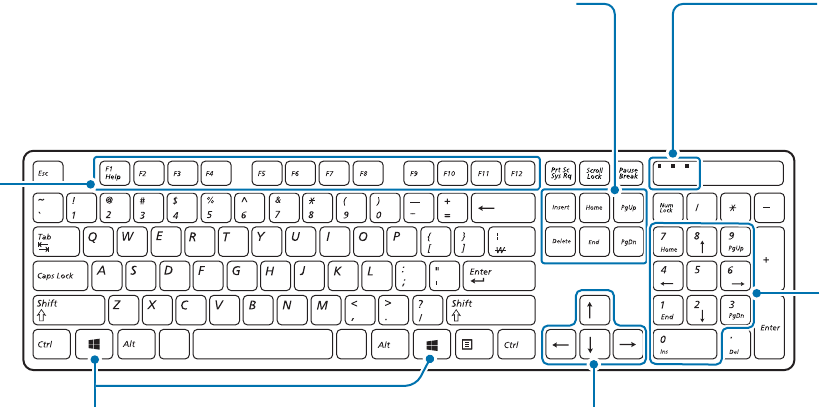
17
Basics
Wired keyboard/mouse (optional)
Wired keyboard
Use the keyboard to enter characters and perform various functions.
Directional keys
Moves the cursor up,
down, left, or right.
Number keys
The numeric keypad can be used
when the Num Lock key is
pressed.
Indicator light
Indicates if the Num Lock, Caps
Lock, and Scroll Lock keys are
activated.
Function keys
Performs specific software
functions. Functions may differ
depending on the program.
Special keys
Delete or insert text, move the cursor to the beginning
or the end of the line, or scroll up or down the page.
Windows key
Displays the Start menu.
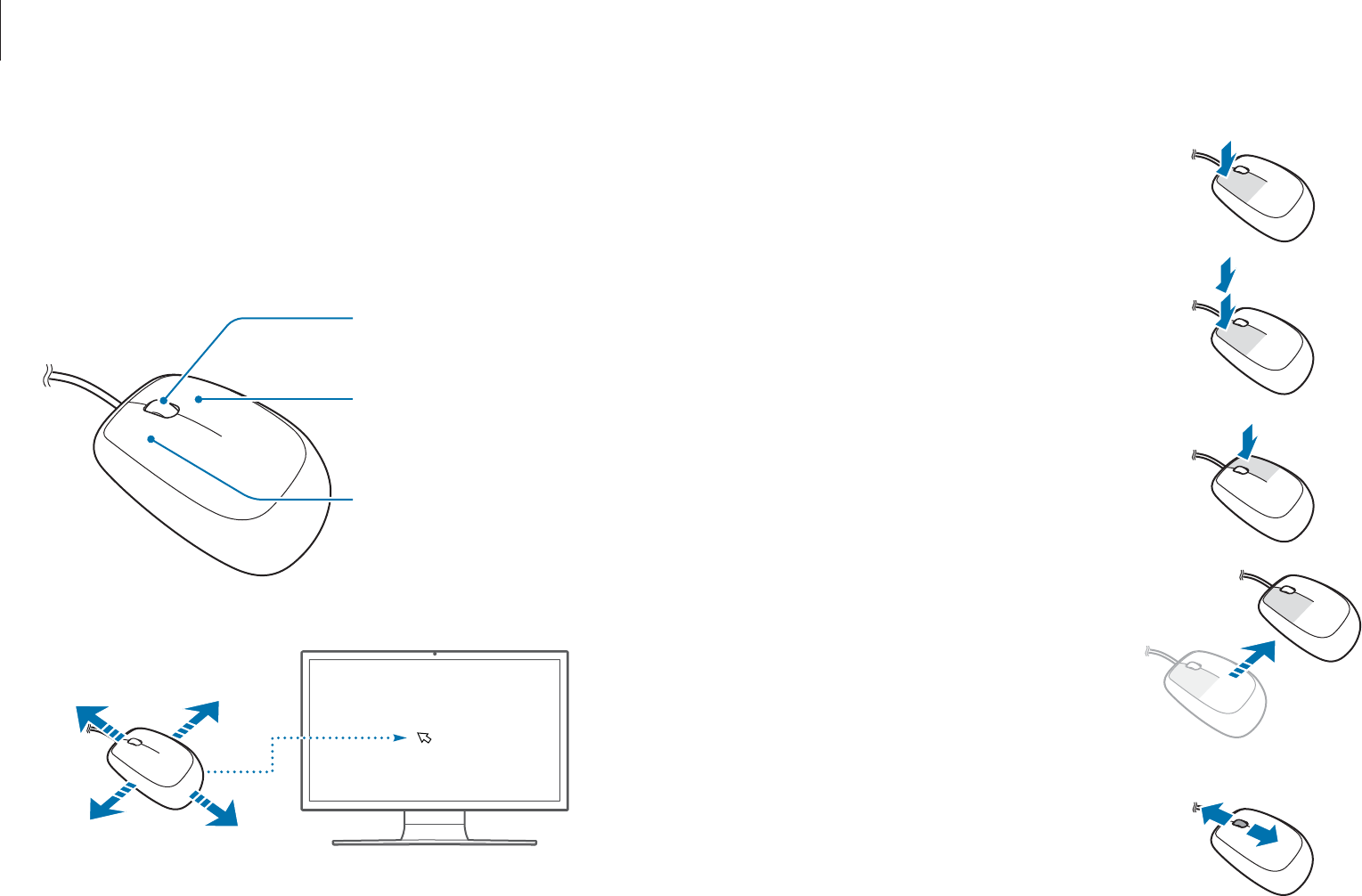
Basics
18
Clicking
Briefly press the left mouse button once.
Click this button once to select an item.
Double-clicking
Rapidly click the left mouse button twice.
Double-click an item to launch it.
Right-clicking
Click the right mouse button once to
display the context-sensitive menu for
the current program.
Dragging
Use the mouse to position the cursor on
an item to be moved. Then, click the left
mouse button and move the item while
the left mouse button is held down.
Scrolling
Move the wheel in either direction
to move through a screen in either
direction when the page is larger than
the computer screen.
Wired mouse
A mouse controls the cursor on the screen.
The appearance of the provided mouse may differ depending on
the model.
Right button
Shows context-sensitive menus
for the current program.
Left button
Selects and launches an item.
Wheel button
Moves the cursor up and down.
If you move the mouse, the cursor moves in the same direction on
the screen.
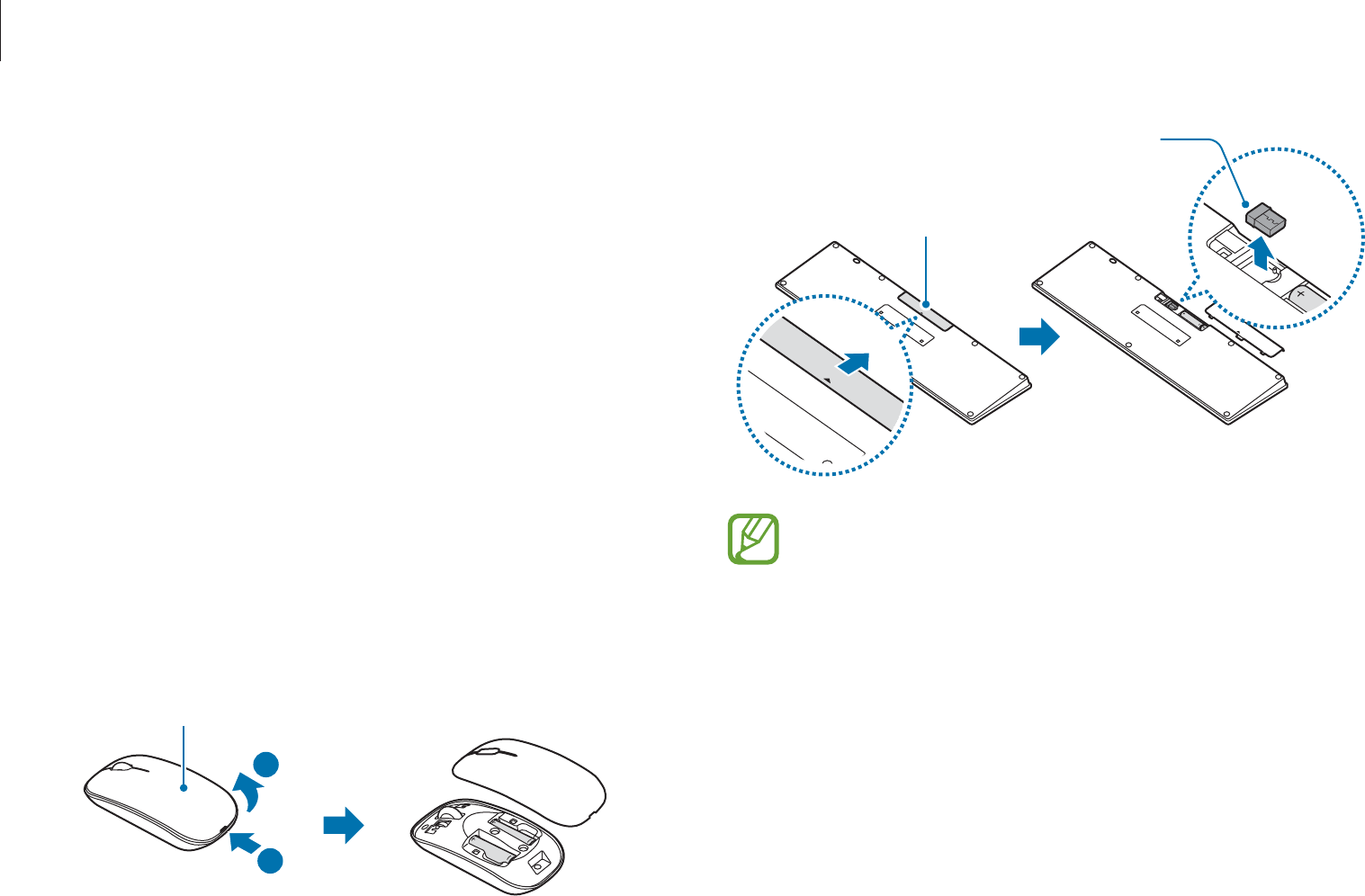
Basics
19
[Wireless keyboard]
Battery cover
Wireless receiver
r
Ensure the positive (+) and negative (-) ends of the
batteries are positioned correctly.
r
The AAA batteries supplied with the product cannot be
recharged.
Wireless keyboard/mouse
(optional)
The wireless keyboard and mouse are optional and the
appearance may differ depending on the model.
Some models may be supplied with a wired keyboard and mouse.
To use the wireless mouse and keyboard, first install the batteries
and then install the wireless receiver.
Installing the wireless receiver
1Open the wireless mouse and keyboard’s battery covers and
insert the batteries. Make sure to insert the batteries with the
positive (+) and negative (-) ends in the right direction, and
remove the wireless receiver from the wireless keyboard.
1
2
[Wireless mouse]
Battery cover
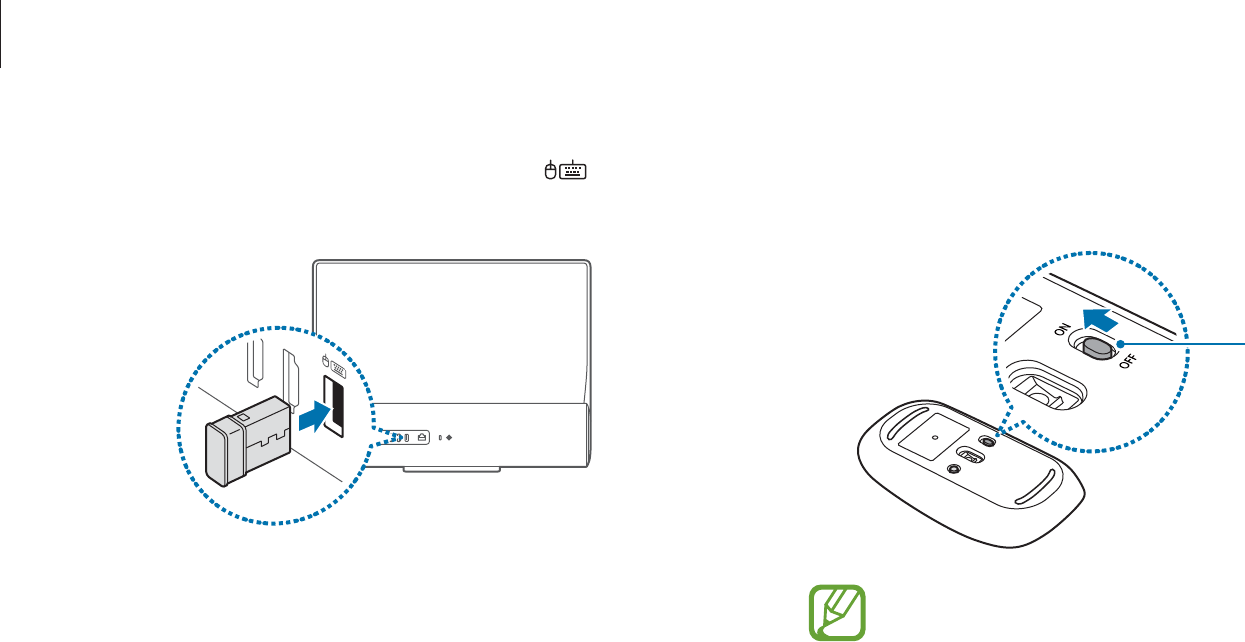
Basics
20
3Move the switch at the bottom of the mouse to the ON
position. You can now use your wireless keyboard and mouse.
Power switch
Set the switch to the OFF
position when the mouse
is not in use to save the
battery power.
r
The wireless keyboard and wireless mouse can operate
within 5 meters of the wireless signal sensor.
r
The range is based on the operating environment. If
there is electromagnetic interference present, such
as that created by a Wi-Fi network AP, the range may
decrease.
2Connect the wireless receiver to a USB port ( ) at the back
of the computer.
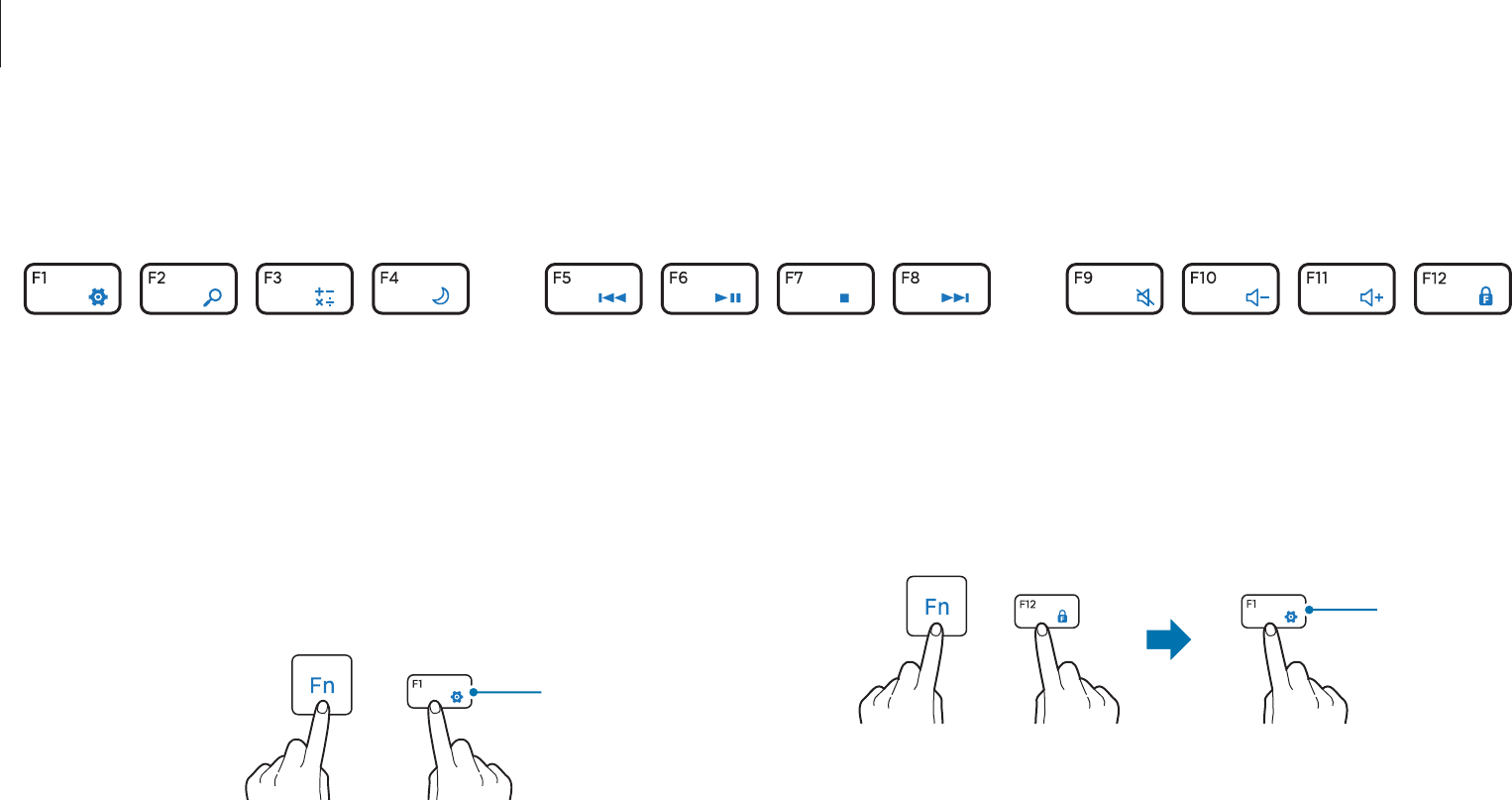
Basics
21
Using the hot keys
Choose one of the following methods to use a hot key.
Ź
Method 1
Press and hold the
Fn
key and then press a hot key.
+
Hot key
Wireless keyboard
Use the keyboard to enter characters and perform various functions.
Ź
Method 2
Press and hold the
Fn
key and press the
F12
.
When the Fn Lock LED turns on, press a hot key.
+
Hot key
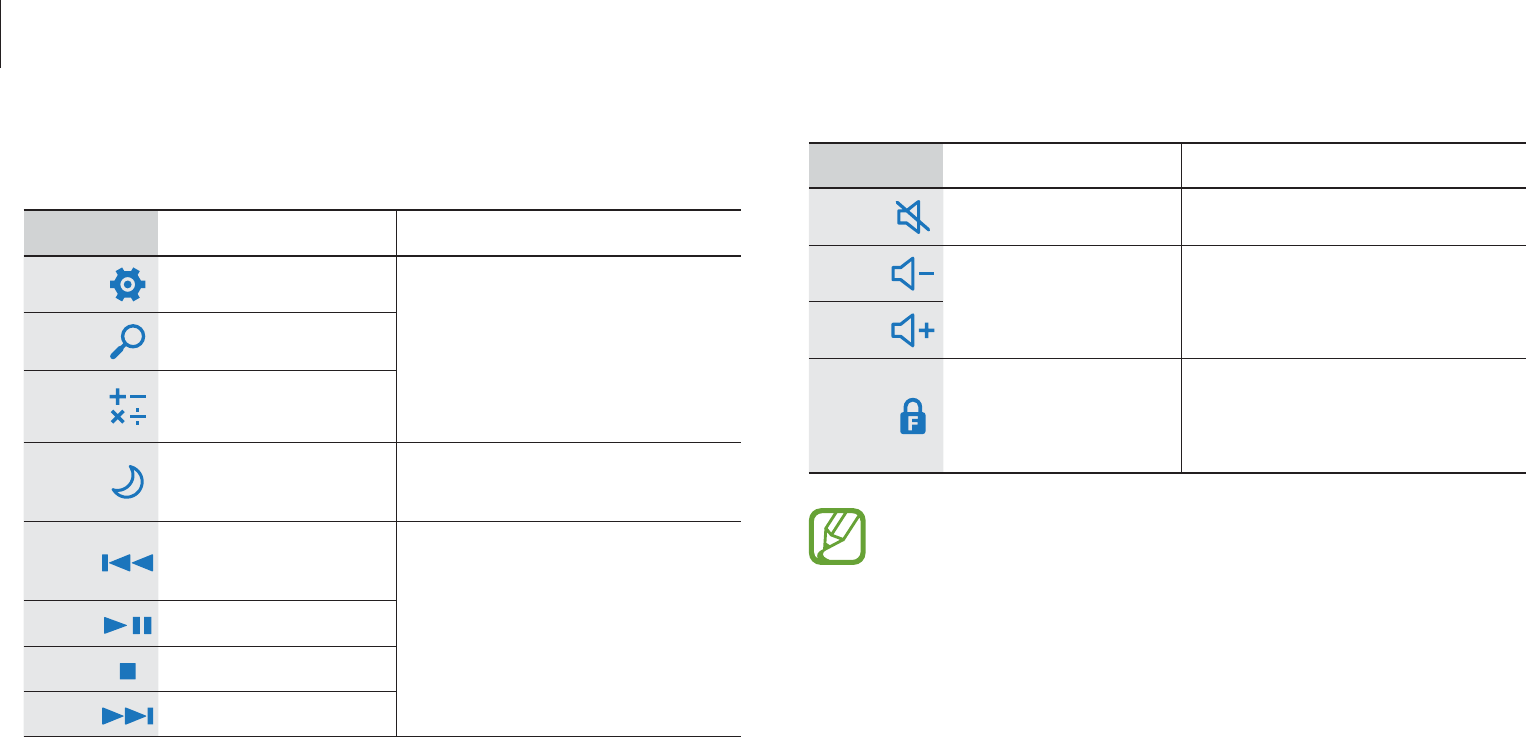
Basics
22
Hot key functions
Key/Icon Function Description
F1
Setup The functions are based on
Windows menus. The key
will activate the function
if it is supported by the
operating system.
F2
Search
F3
Calculator
F4
Power saving mode Switch to power saving
mode.
F5
Play the previous
file
Multimedia playback
F6
Play/Pause
F7
Stop
F8
Play the next file
Key/Icon Function Description
F9
Mute Toggle the sound on and off.
F10
Volume control Adjust the volume.
F11
F12
Fn Lock
Press this key to make the
Fn
key function as if it is
pressed.
The wireless keyboard automatically enters power saving
mode if there is no key input for a preset period. When the
keyboard is in power saving mode, press any key to start
using it again. The wireless keyboard cannot be turned off.
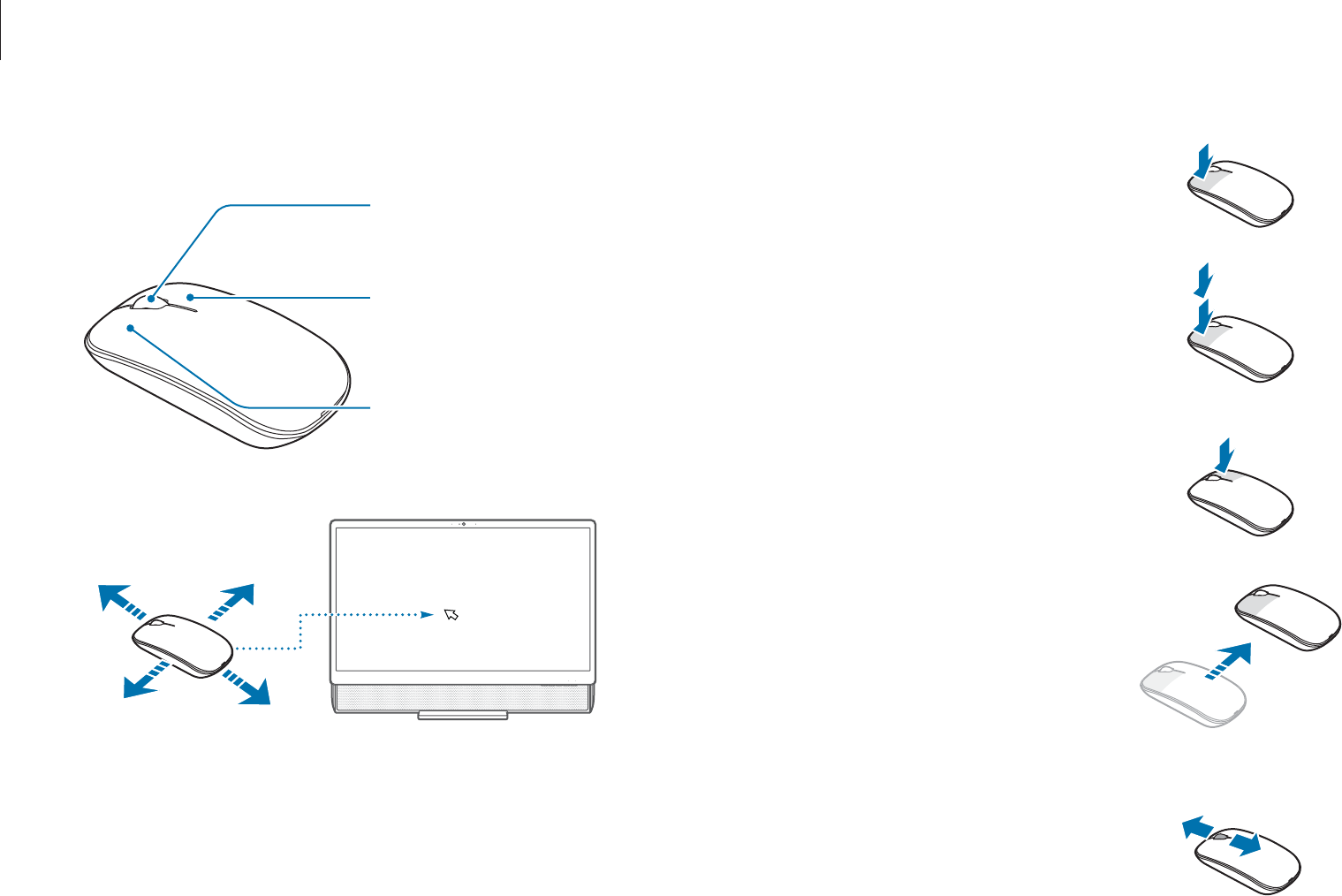
Basics
23
Wireless mouse
Right button
Show context-sensitive menus
for the current program.
Left button
Select and launches an item.
Wheel button
Moves the cursor up and
down.
When you move the mouse, the cursor on the screen moves in the
same direction.
Clicking
Briefly press the left mouse button once.
Click this button once to select an item.
Double-clicking
Rapidly click the left mouse button
twice.
Double-click an item to launch it.
Right-clicking
Click the right mouse button once to
display the context-sensitive menu for
the current program.
Dragging
Use the mouse to position the cursor on
an item to be moved. Then, click the left
mouse button and move the item while
the left mouse button is held down.
Scrolling
Move the wheel in either direction
to move through a screen in either
direction when the page is larger than
the computer screen.
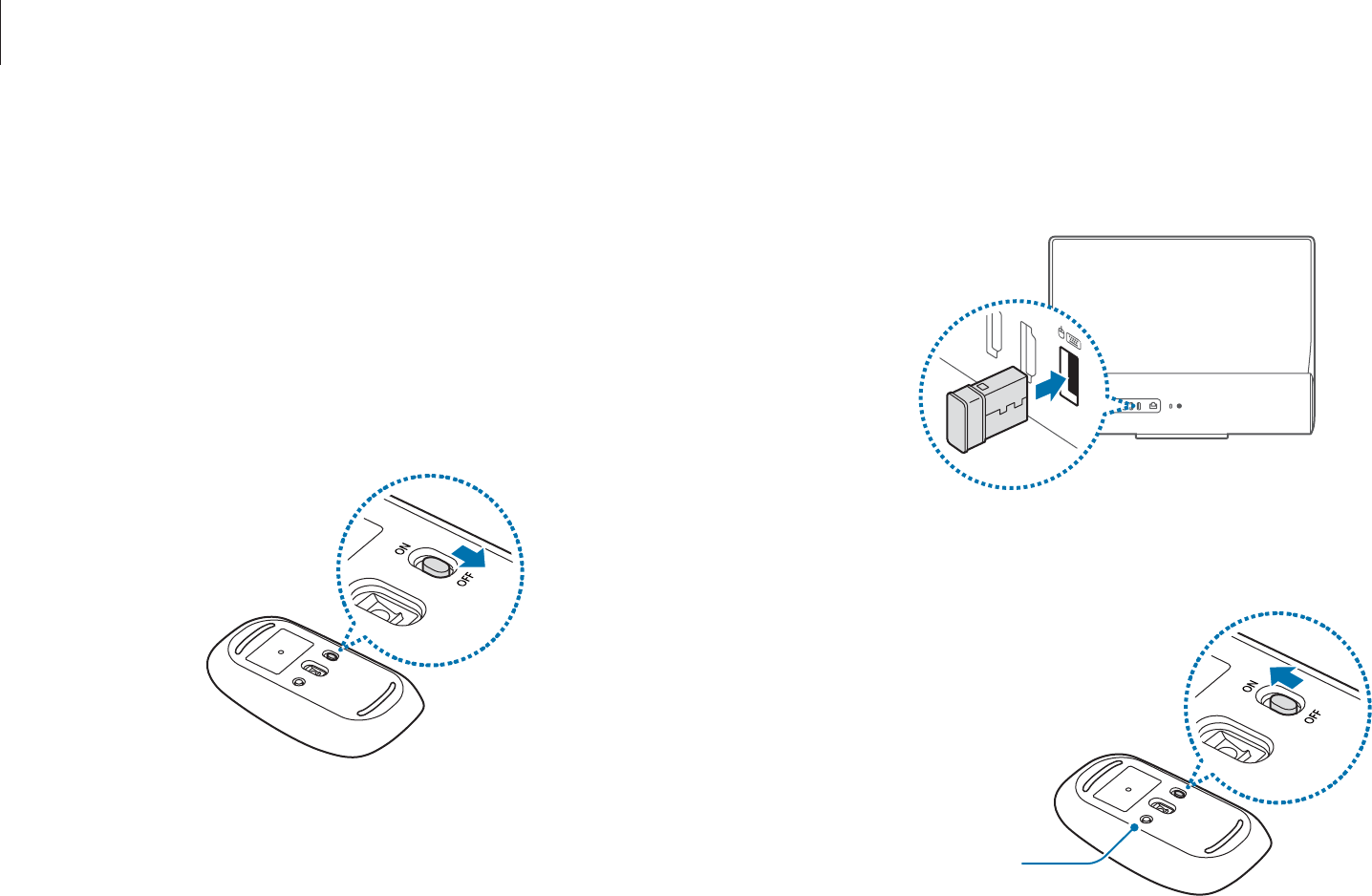
Basics
24
2Disconnect the wireless receiver from the USB port and then
reconnect it.
3Return the switch on the mouse to the ON position.
CONNECT button
If the wireless mouse does not work
Ź
Ensure that the switch on the bottom side of the mouse is in
the ON position.
Ź
Check the batteries.
Ź
Check the wireless receiver connection.
1Slide the switch on the bottom side of the mouse to the OFF
position.
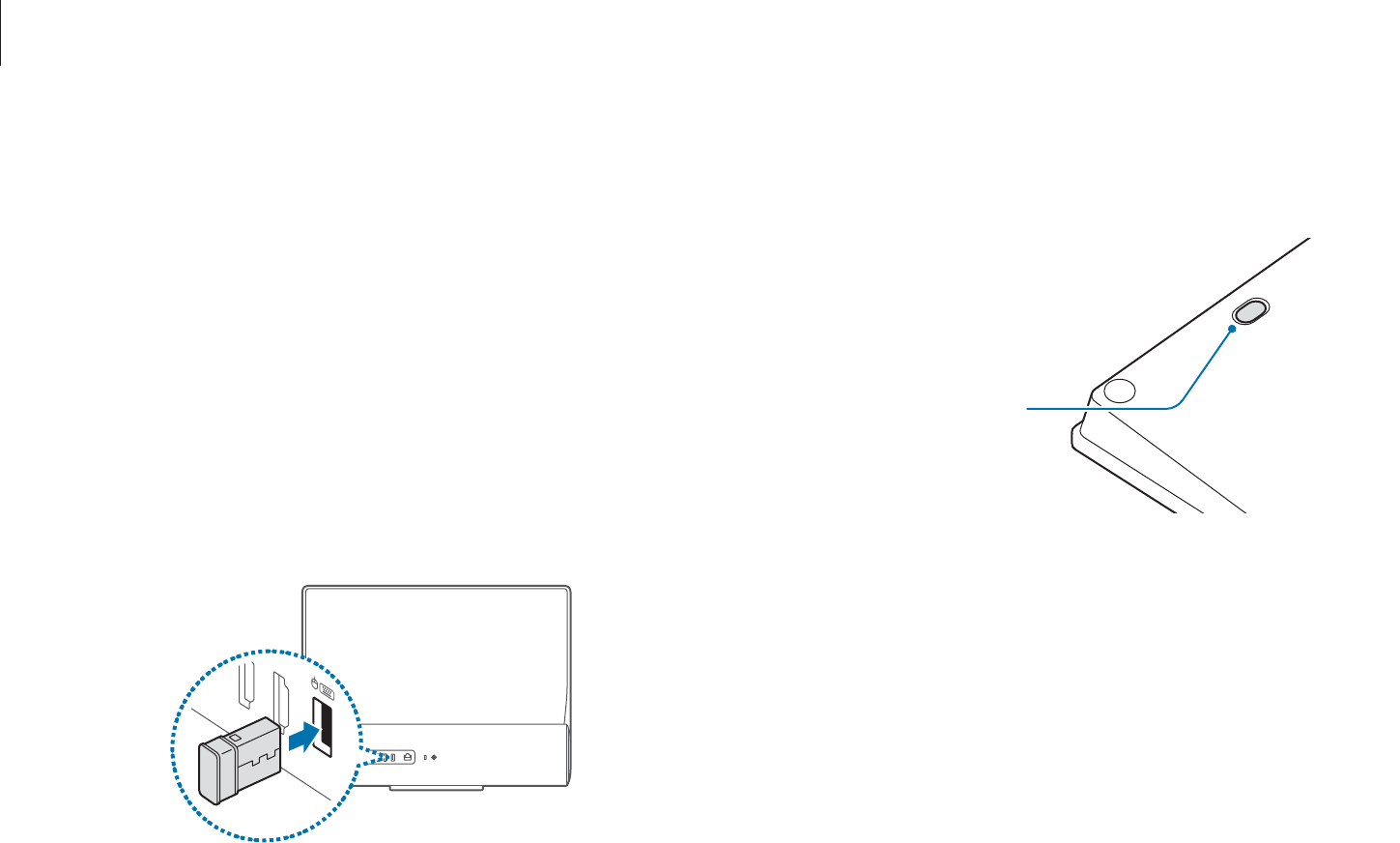
Basics
25
2Immediately place the keyboard near the receiver. Then,
briefly press and hold the CONNECT button.
CONNECT button
3Check that the wireless keyboard is operating properly.
4Immediately place the mouse near the receiver. Then, briefly
press and hold the CONNECT button.
5Check that the wireless mouse is operating properly.
If the wireless keyboard does not work
Ź
Check the batteries.
Ź
Check the wireless receiver connection.
1Disconnect the wireless receiver from the USB port and then
reconnect it.

Basics
26
To use a mini or micro card, insert the card into an adapter before
inserting it into the memory card slot.
r
Some memory cards may not be fully compatible with
the computer. Using an incompatible card may damage
the computer or the memory card, or corrupt the data
stored in it.
r
Use caution to insert the memory card in the indicated
direction.
r
Store the card separately to prevent losing the card
when moving the computer.
r
Memory card speeds vary.
Memory card
Use a memory card to transfer data to other devices, such as
digital cameras or MP3 players. Memory cards are sold separately.
Purchase a memory card with the necessary capacity for the
requirement.
This computer supports the following types of memory cards.
Abbreviation Description
SD
r
Secure Digital
mini SD
r
mini Secure Digital
micro SD
r
micro Secure Digital
SDHC
r
Secure Digital High Capacity
mini SDHC
r
mini Secure Digital High Capacity
micro SDHC
r
micro Secure Digital High Capacity
SDXC
r
Secure Digital eXtended Capacity
micro SDXC
r
micro Secure Digital eXtended Capacity
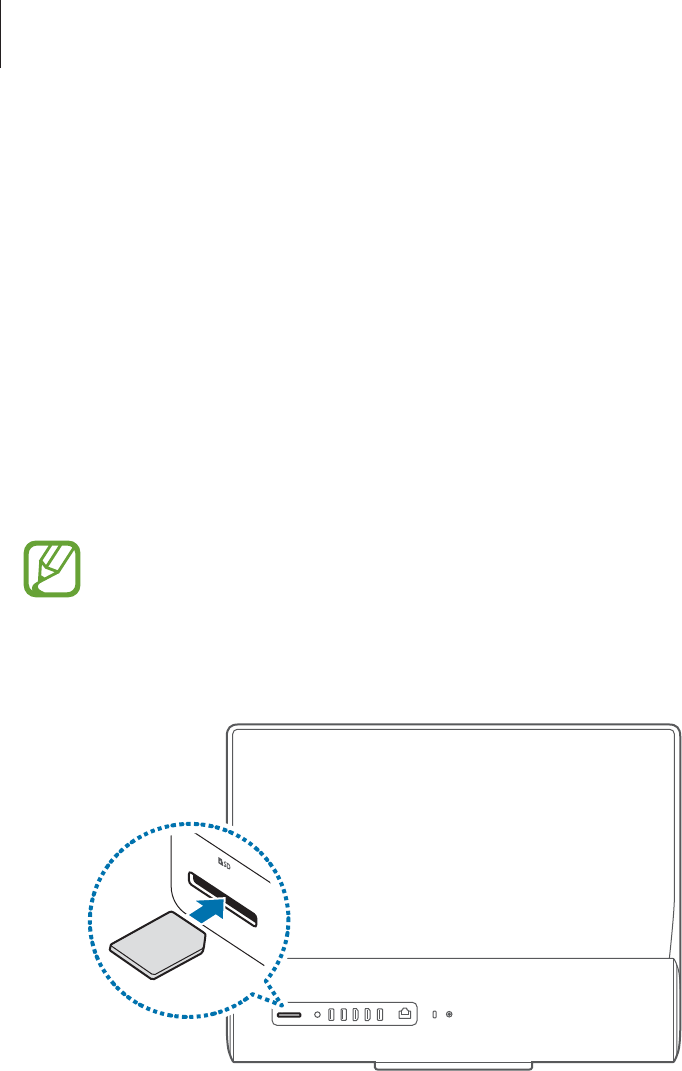
Basics
27
3Select the pop-up message to open the memory card folder.
If a pop-up message appears, select the corresponding
window
ĺ
Continue without scanning
.
4Select
Open folder to view files
.
5Save, move, or delete data on the memory card.
The memory card folder opens only on the desktop.
Inserting a memory card
1If a dummy card or a memory card adapter is inserted in the
memory card slot, remove it.
2Insert a memory card into the memory card slot in the
indicated direction.
Use a memory card adapter to insert a micro memory card
into the memory card slot. For mini memory cards, use a mini
card adapter.
You can insert a micro memory card into the memory card
adapter.
The memory card adapter is optional and must be
purchased separately.

Basics
28
r
To use a memory card to exchange data with a digital
device, such as a digital camera, formatting the data
with the digital device is recommended.
r
When trying to use a formatted memory card in
another digital device, format the memory card again in
the device.
r
Data protected by copyright laws cannot be reviewed
or modified.
r
Inserting and removing a memory card repeatedly may
damage the memory card.
r
Secure Digital Input Output (SDIO) is not supported.
r
If the write-protect tab is in the locked position, you
cannot format, write, or delete data on the card.
Removing a memory card
Grasp the end of the card and pull it out of the slot.
Formatting a memory card
Format the memory card to remove all data or before using it for
the first time.
Formatting a memory card deletes all data saved on
the card. If necessary, back up important data before
formatting the card.
1On the taskbar, select File Explorer ( ).
2Right-click the memory card drive, and then select
Format
.
3Select
Start
.

Basics
29
2On the desktop screen, right-click the Start button ( ) and
select
Control Panel
ĺ
Appearance and Personalization
ĺ
Display
ĺ
Change display settings
ĺ
Multiple displays
ĺ
an option.
Select a mode.
Duplicate these
displays
Show the screen on both the computer and
the external display.
Extend these
displays Extend the screen to the external display.
Show only on 1 Show the screen on the computer monitor
only.
Show only on 2 Show the screen on the external display only.
An external display is not supported when using the DOS
Command Prompt window.
External display
Connecting the computer to an external display device can be
useful for presentations or when watching a movie. The cables
required to connect an external display are sold separately. The
computer supports HDMI cables.
Connecting to a display
1Connect the HDMI output port on the computer to the HDMI
input port on the external display using an HDMI cable.
r
This option is available on computers that have an
HDMI output port only.
r
If the computer is connected to an external display,
change the external input mode on the external display
to HDMI.
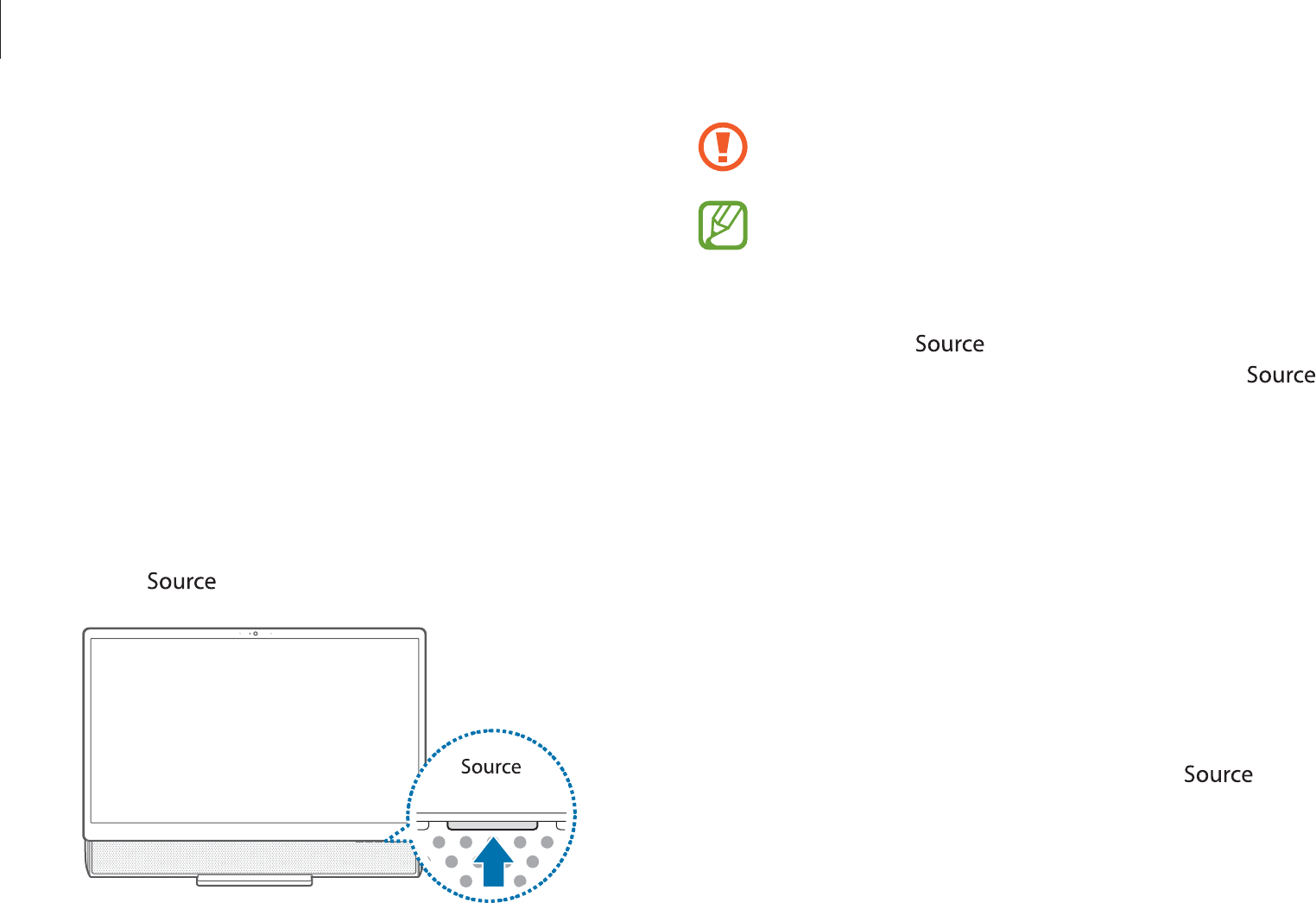
Basics
30
Monitor mode is only available when a source is detected
at the HDMI-IN port.
r
If the computer is turned off, the LCD can still be used as
a monitor as long as the power adapter is connected to
an electrical outlet.
r
Even if the product is switched to Monitor mode by
pressing the button during an operation, the
operating system does not shut down. Press the
button again to return to PC Mode.
r
When the computer is in Monitor mode the external
audio is also switched to the computer.
r
If no video signal is displayed on the LCD in Monitor
mode, disconnect and reconnect the HDMI cable.
r
When the computer is in Power saving mode or its
system turns off while in Monitor mode, press the LCD
ON/OFF button to wake the computer.
Using the screen in PC mode
To return to PC mode from Monitor mode, press the
button.
Using the LCD as an external
monitor (optional)
The computer’s LCD can be used as an external monitor by using
the Digital Video and Audio Input ports (HDMI-IN).
You can connect to HDMI-enabled devices, such as a computer, a
gaming console, or a DVD player.
Connecting the LCD as an external monitor
1Use an HDMI cable to connect the external device’s HDMI-
OUT port and the computer’s HDMI-IN port.
Press the button to switch to the Monitor mode.
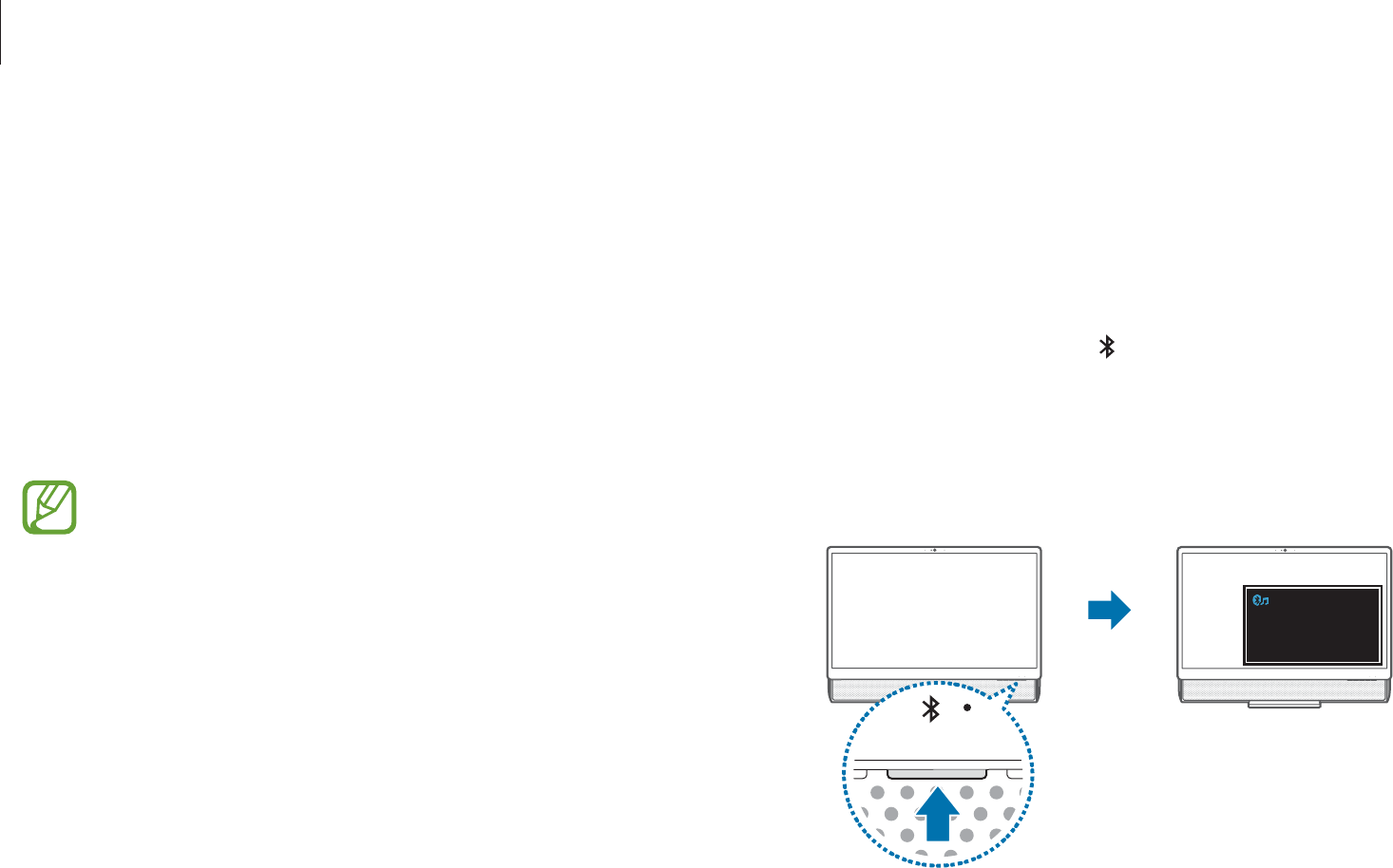
Basics
31
Connecting the computer to a mobile device
using Bluetooth
If you connect the computer and the mobile device via Bluetooth
for the first time, perform the following steps.
1Press the Bluetooth button ( ) on the computer to turn on the
Bluetooth speaker.
After the alarm notifies you that the Bluetooth feature has
been activated, the Bluetooth LED will blink and
Pairing
will
be displayed on the computer screen.
Bluetooth Music Play
Pairing
Playing music from a mobile
device through the computer’s
speakers (optional)
Use the Bluetooth feature to play music stored on a mobile device,
such as a smartphone or tablet, through the computer’s speakers.
You can use the computer as a speaker by connecting a mobile
device to the computer even if it is off.
r
This feature is available with Bluetooth-enabled mobile
devices only.
r
Maintain the distance between the computer and the
mobile device within the Bluetooth connection range.
r
The layout of the screen and controls vary based on the
device model and the software version.
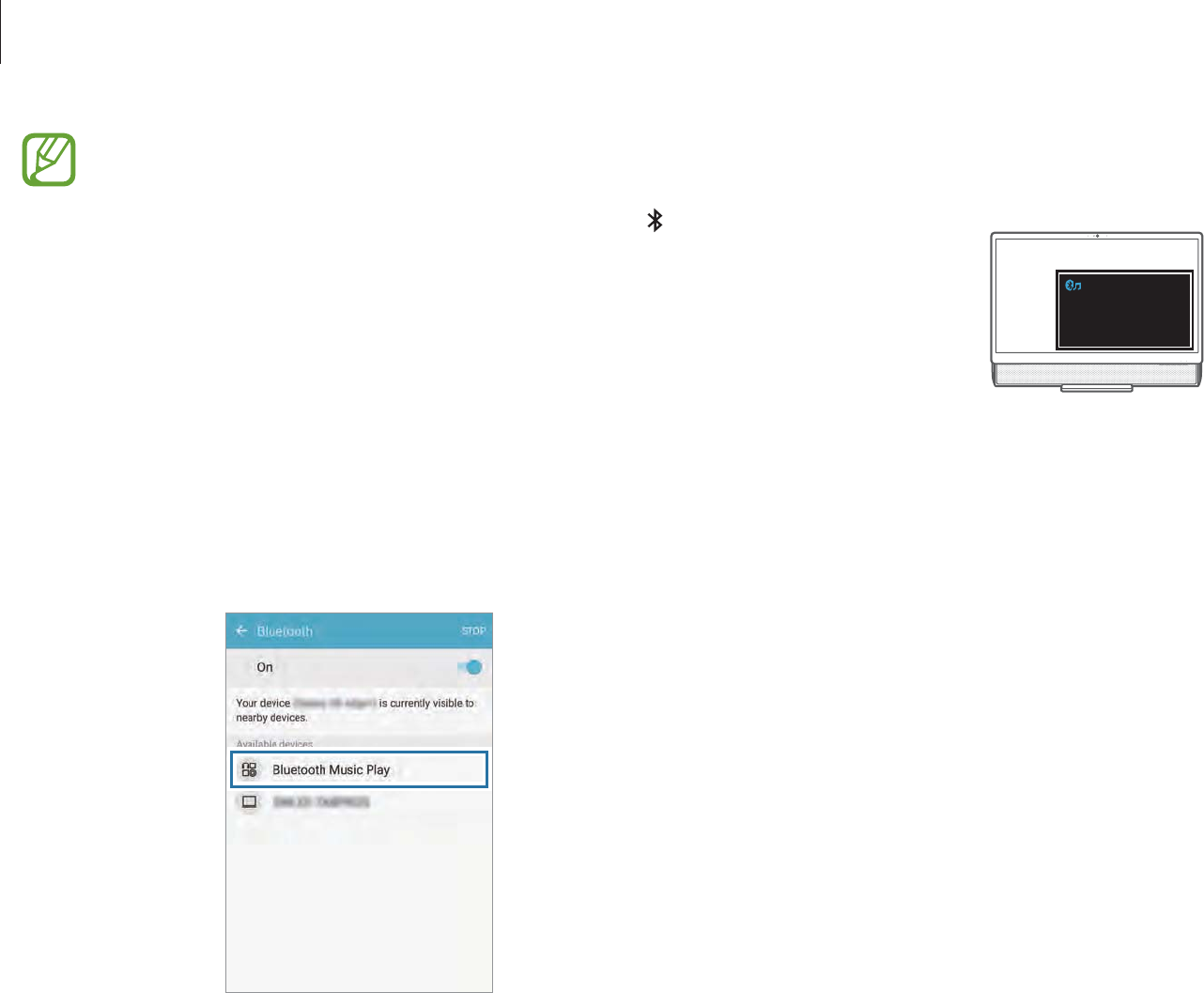
Basics
32
When the devices are paired,
Connected
is displayed on the
computer screen.
Bluetooth Music Play
Connected
You can now select a music file stored on the mobile device
and listen to it using the computer’s speakers.
r
Other devices, such as smartphones, can pair with the
computer only when it is in Bluetooth pairing mode.
r
After pairing, press and hold the Bluetooth button ( )
for more than three seconds to reconnect the computer
and the mobile device.
Pairing
will be displayed on the
computer screen.
On the mobile device, activate the Bluetooth feature and tap
Bluetooth Music Play
. For more information, refer to your
mobile device’s manual.
On a Samsung smartphone, tap
Settings
ĺ
Bluetooth
,
and then tap the Bluetooth switch to activate it. Then, tap
Bluetooth Music Play
.
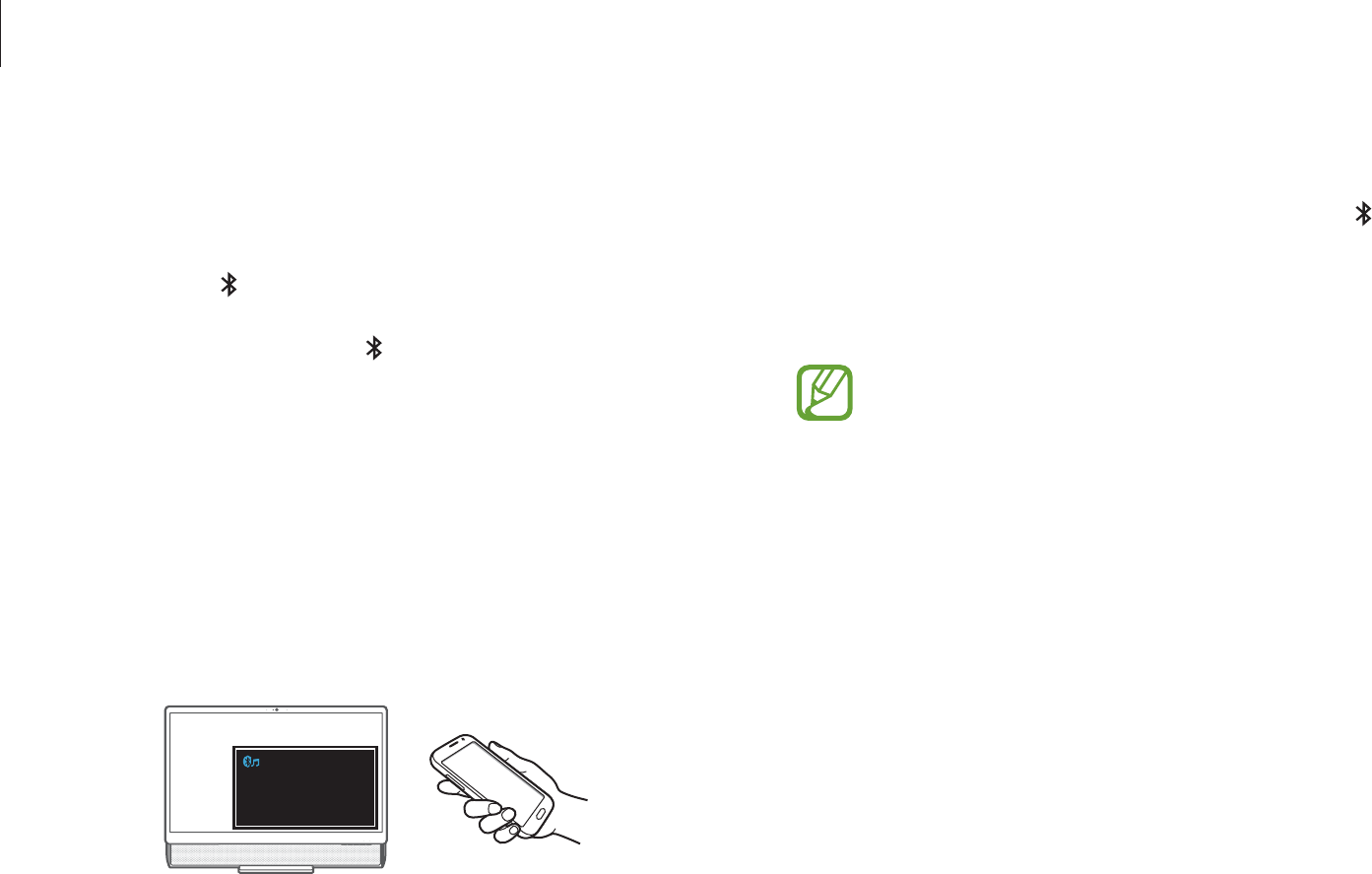
Basics
33
Turning off the computer speakers
To turn off the speakers, press the Bluetooth button ( ) on the
computer.
The Bluetooth LED will turn off and
Off
will be displayed in the
lower-right corner of the screen.
r
If the speakers do not work properly, check the
Bluetooth connection and try again. Refer to
Connecting the computer to a mobile device using
Bluetooth for more information.
r
If the devices are no longer paired, position the mobile
device near to the computer and try again.
r
When music stored on the mobile device is playing
through the computer’s speakers, the volume is not
controlled at the computer. To adjust the volume, use
the volume controls on the mobile device.
Using the computer’s speakers
If the computer and the mobile device have been connected
previously, you can easily connect them again by pressing the
Bluetooth button ( ).
1Press the Bluetooth button ( ) on the computer. The
Bluetooth LED turns on.
The computer’s speakers turn on and
Ready
is displayed in
the lower right corner of the computer screen.
2Move the mobile device near to the computer to
automatically connect the two devices.
When the devices are connected,
Connected
appears on the
computer screen.
Bluetooth Music Play
Connected
3Select and play a song.
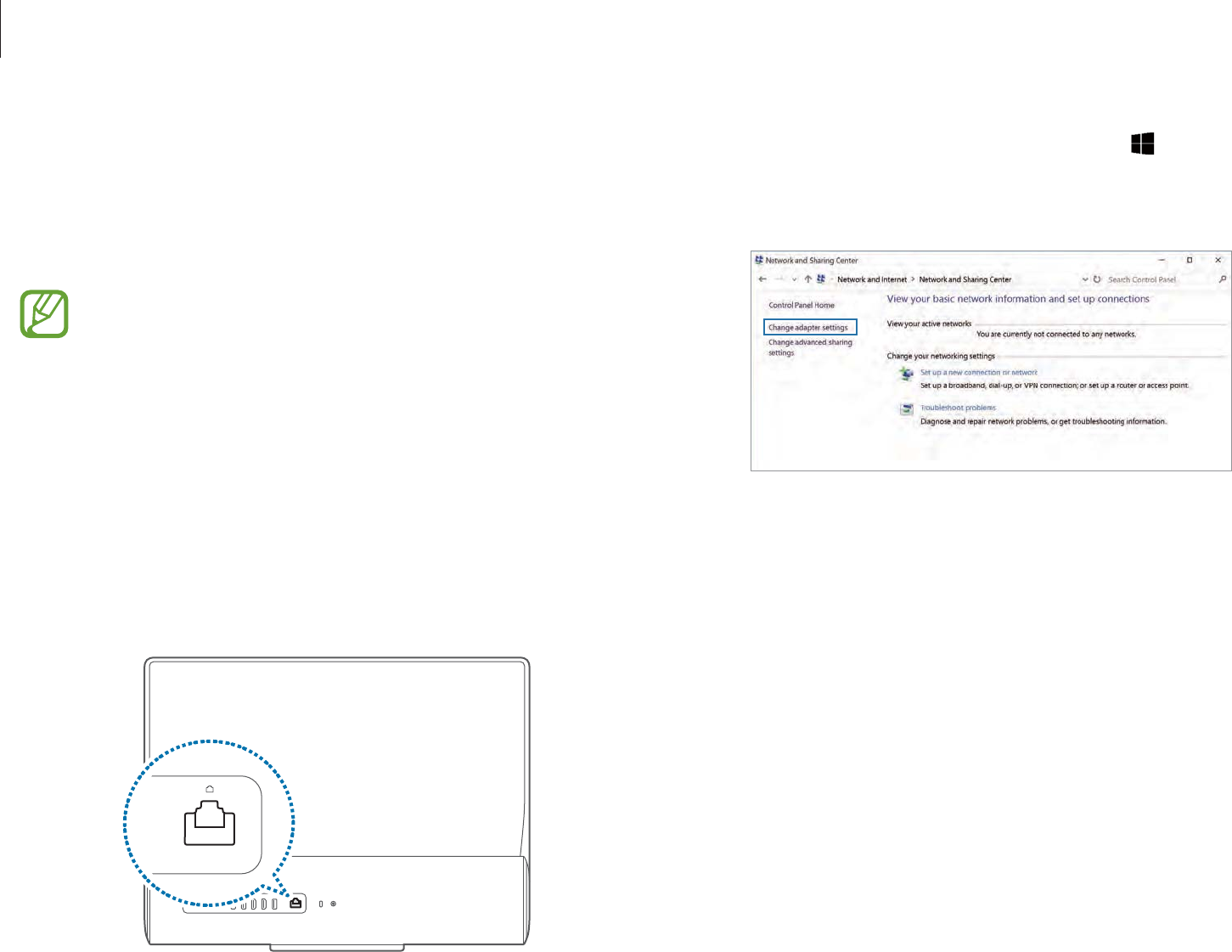
Basics
34
2On the desktop, right-click the Start button ( ) and select
Control Panel
ĺ
Network and Internet
ĺ
Network and
Sharing Center
ĺ
Change adapter settings
.
3Right-click
Ethernet
and select
Properties
. The LAN device
name may differ depending on the computer’s network
device.
Wired LAN
To access the Internet at home, set up an account with an Internet
service provider (ISP). To purchase Internet service and a modem,
contact a local ISP.
r
Some features or procedures may differ depending on
the model.
r
These descriptions are written for Windows 10, so some
figures and descriptions may differ from your operating
system. Since the procedures for other Windows
operating systems are similar, use the computer
referring to these descriptions.
Wired LAN
1Connect a LAN cable to the LAN port on the computer.
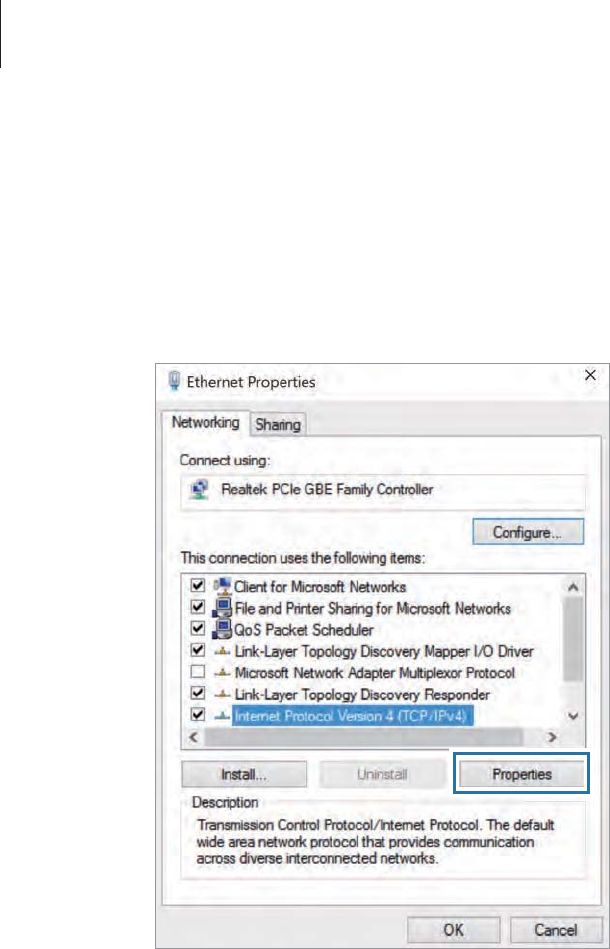
Basics
35
5Configure the IP settings.
r
When using DHCP, select
Obtain an IP address
automatically
.
r
When not using DHCP, contact the network administrator
for the IP address. To use a static IP address, select
Use the
following IP address
and set the IP address manually.
6Select
OK
to save the settings.
4Select
Internet Protocol Version 4 (TCP/IPv4)
from the
list below
This connection uses the following items
ĺ
Properties
.
r
The Network Component name may differ depending on
the operating system.
r
To add a network item such as a client, service, or protocol,
select
Install...
under the list of network items.

Basics
36
4Restart the computer.
r
If the computer wakes up from sleep mode inadvertently,
disable the Wake on LAN feature.
r
This feature may not work while using other power saving
features. To disable other sleep functions, right-click the
Start button ( ) and select
Control Panel
ĺ
Hardware
and Sound
ĺ
Power Options
.
When connected to a 100 Mbps/1 Gbps wired LAN, a
message appears informing the user of connection to
a 10 Mbps/100 Mbps wired LAN when the computer
wakes from sleep mode. This happens because restoring
the network takes about 3 seconds. When the network
is restored, the computer will be connected to the
100 Mbps/1 Gbps LAN.
Wake on LAN (WOL) feature
Activate the system remotely from sleep mode when a signal,
such as a magic packet command, is received via a wired LAN.
1On the desktop, right-click the Start button ( ) and select
Control Panel
ĺ
Network and Internet
ĺ
Network and
Sharing Center
ĺ
Change adapter settings
.
2Right-click
Ethernet
and select
Properties
.
3Select
Configure...
ĺ
Power Management
ĺ
Allow this
device to wake the computer
ĺ
OK
.
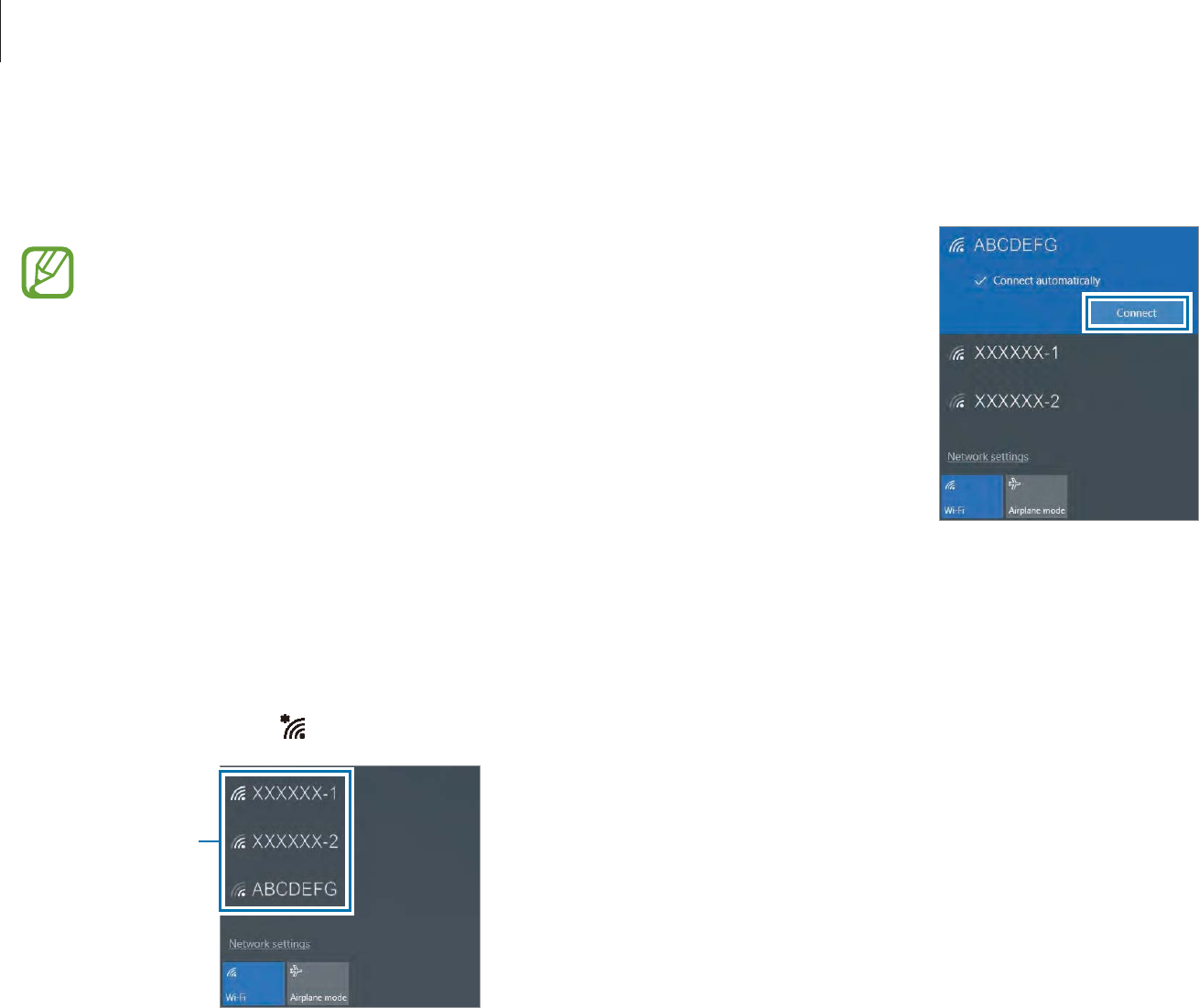
Basics
37
2Select a network from the list of detected wireless networks
and select
Connect automatically
ĺ
Connect
.
3Enter a password, if necessary, and select
Next
.
Once the computer has been connected to a wireless
network, it will attempt to connect to it automatically when
it is available. If you require a network password, contact the
system administrator.
Wireless LAN
Connect the computer to a wireless network to use the Internet.
The descriptions below are for computer models with
a Wireless LAN card or device. A Wireless LAN device is
optional. The pictures in this manual may differ from the
actual product depending on the wireless LAN device
model.
About Access Point (AP)
An Access Point (AP) is a network device that bridges wired
and wireless LANs and corresponds to a wireless hub in a wired
network. Multiple devices can be connected to an AP.
Connecting to a Wi-Fi network
1On the taskbar, select .
AP List
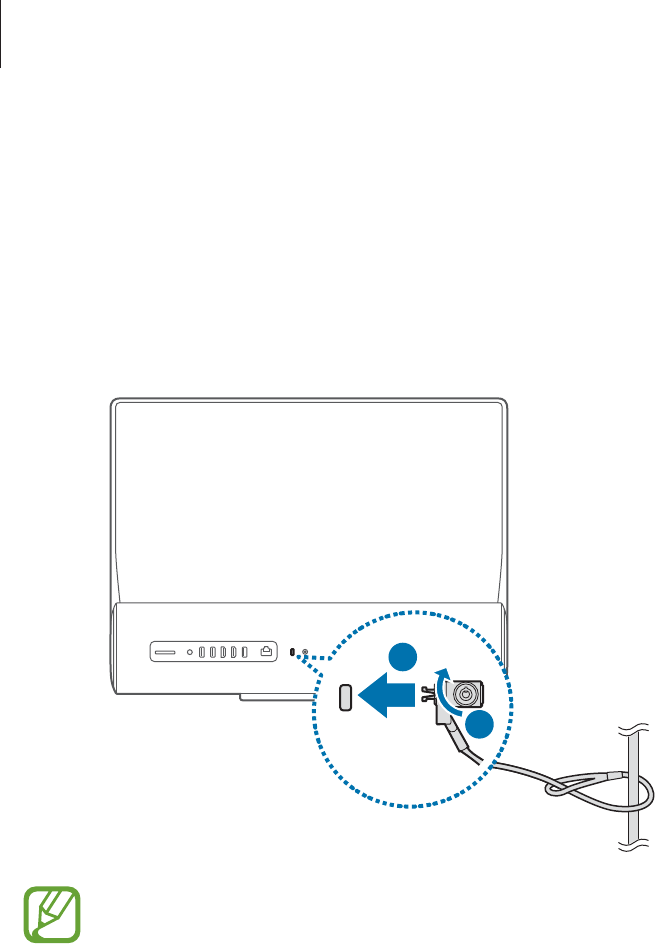
Basics
38
Using the Security slot
You can secure the computer by connecting a lock and cable to
the Security slot.
Tie the lock and cable to a fixed object and install the other end of
the cable to the Security slot.
1
2
To use this feature, you must purchase a lock and cable
(sold separately). Your product may differ from the one
shown above. For more information, refer to your lock’s
manual.

39
Applications
Using applications
r
Images and features may differ depending on the
model and the application version.
r
Some applications may not be supported depending
on the model.
r
Applications that are provided by Samsung can be
installed from
Samsung Update
.
r
Third-party software related services
For descriptions about and service requests for
third-party applications, please contact the relevant
manufacturer. Some troubleshooting actions in
response to service requests may not work depending
on the application manufacturer.
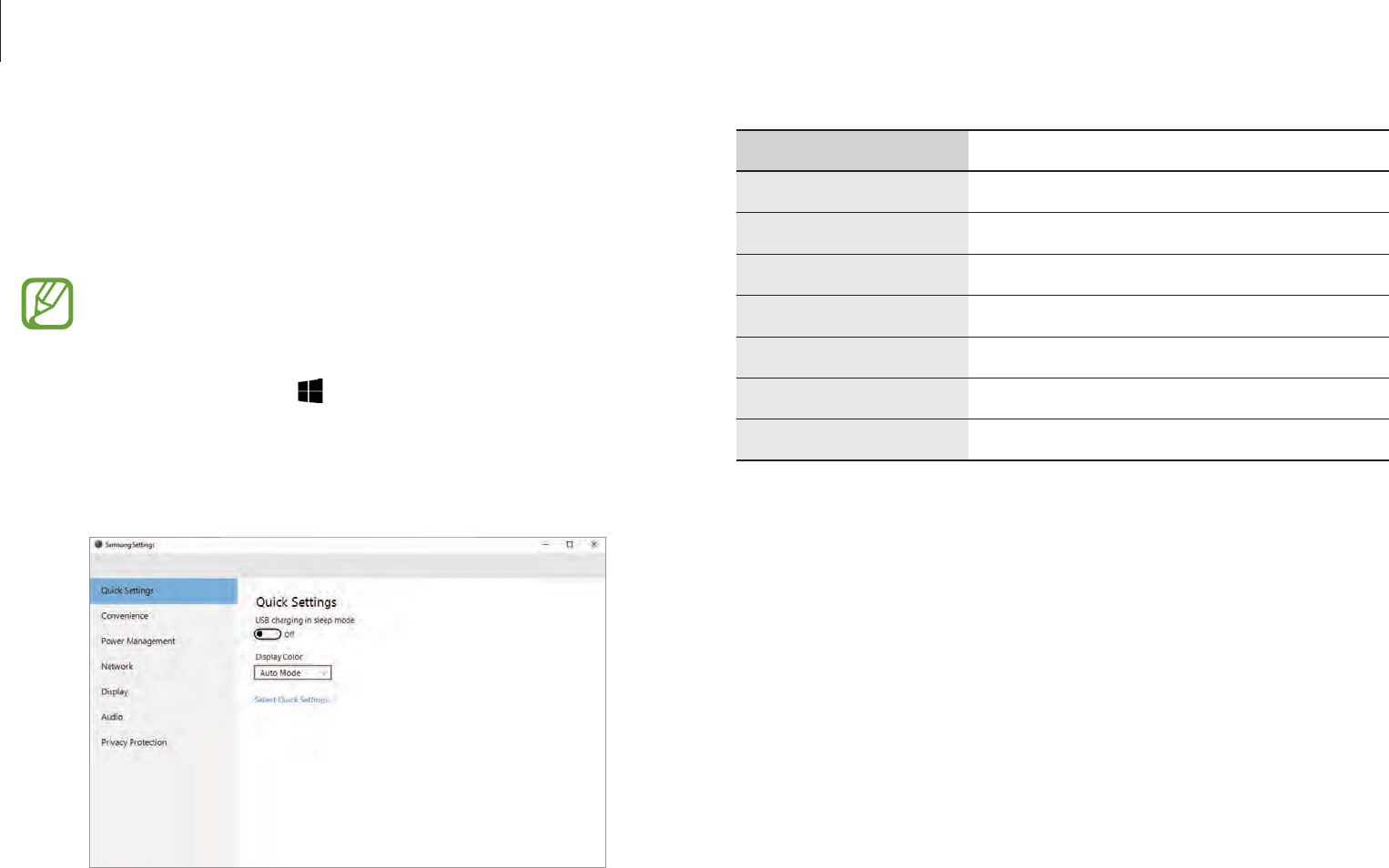
Applications
40
Menu Description
Quick Settings
r
Set quick settings.
Convenience
r
Set system settings.
Power Management
r
Set power-related settings.
Network
r
Set network functions and settings.
Display
r
Set the screen brightness and color.
Audio
r
Set sound settings.
Privacy Protection
r
Set security functions and settings.
Samsung Settings
Samsung Settings
, a Samsung-integrated settings application,
offers various settings functions.
Images and features may differ depending on the model
and the application version.
1Select the Start button ( )
ĺ
Samsung
ĺ
Samsung
Settings
.
2Select an option to configure the corresponding function.
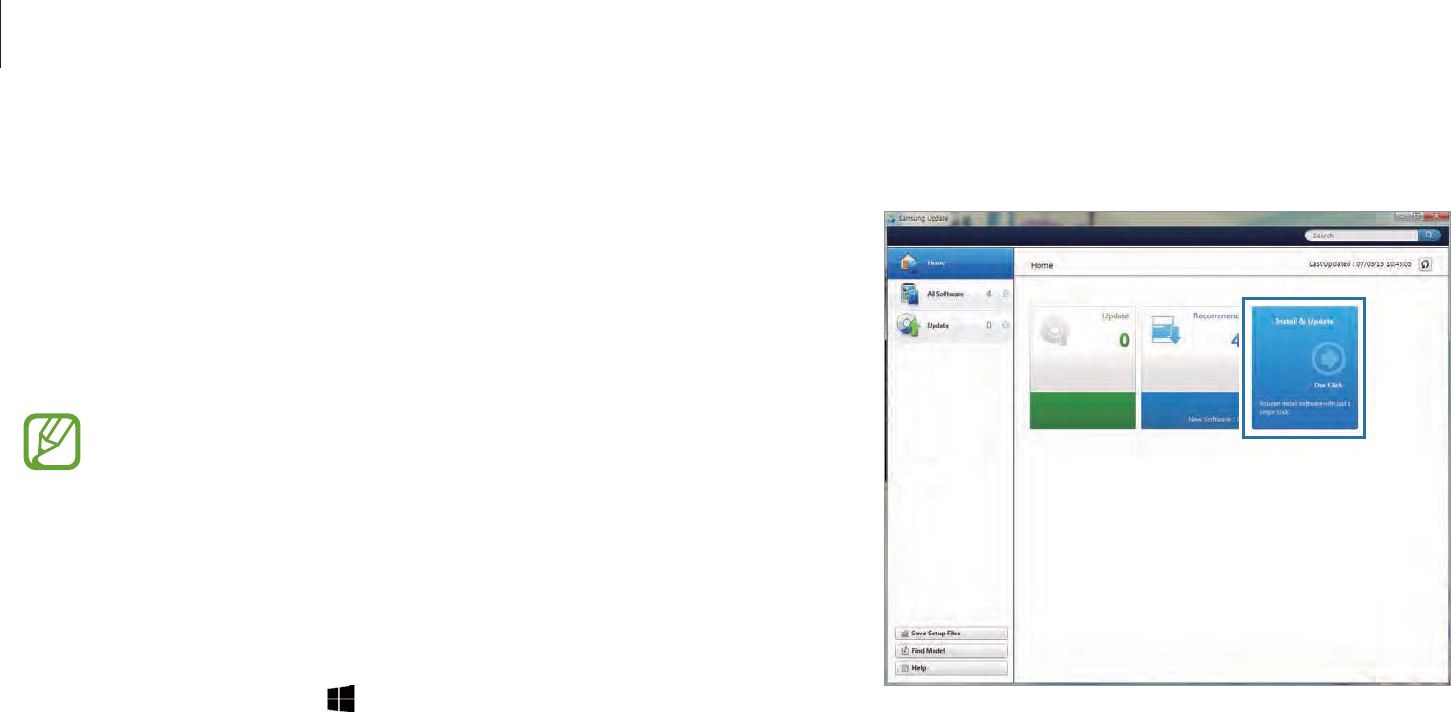
Applications
41
3Select
Install & Update
.
4Select items to update and select
OK
.
Samsung Update
Install and update Samsung applications and drivers on the
computer easily and conveniently. This application enables the
user to search for or download the BIOS, drivers, and applications
over the Internet. Keep the computer performing better and more
stably with
Samsung Update
.
r
To check for available updates, the computer must be
connected to the Internet.
r
Only applications that have been installed with this
application can be updated.
r
Images and features may differ depending on the
model and the application version.
1Select the Start button ( )
ĺ
Samsung
ĺ
Samsung
Update
.
2Read and agree to the User Agreement.
This step appears only when the application runs for the first
time.
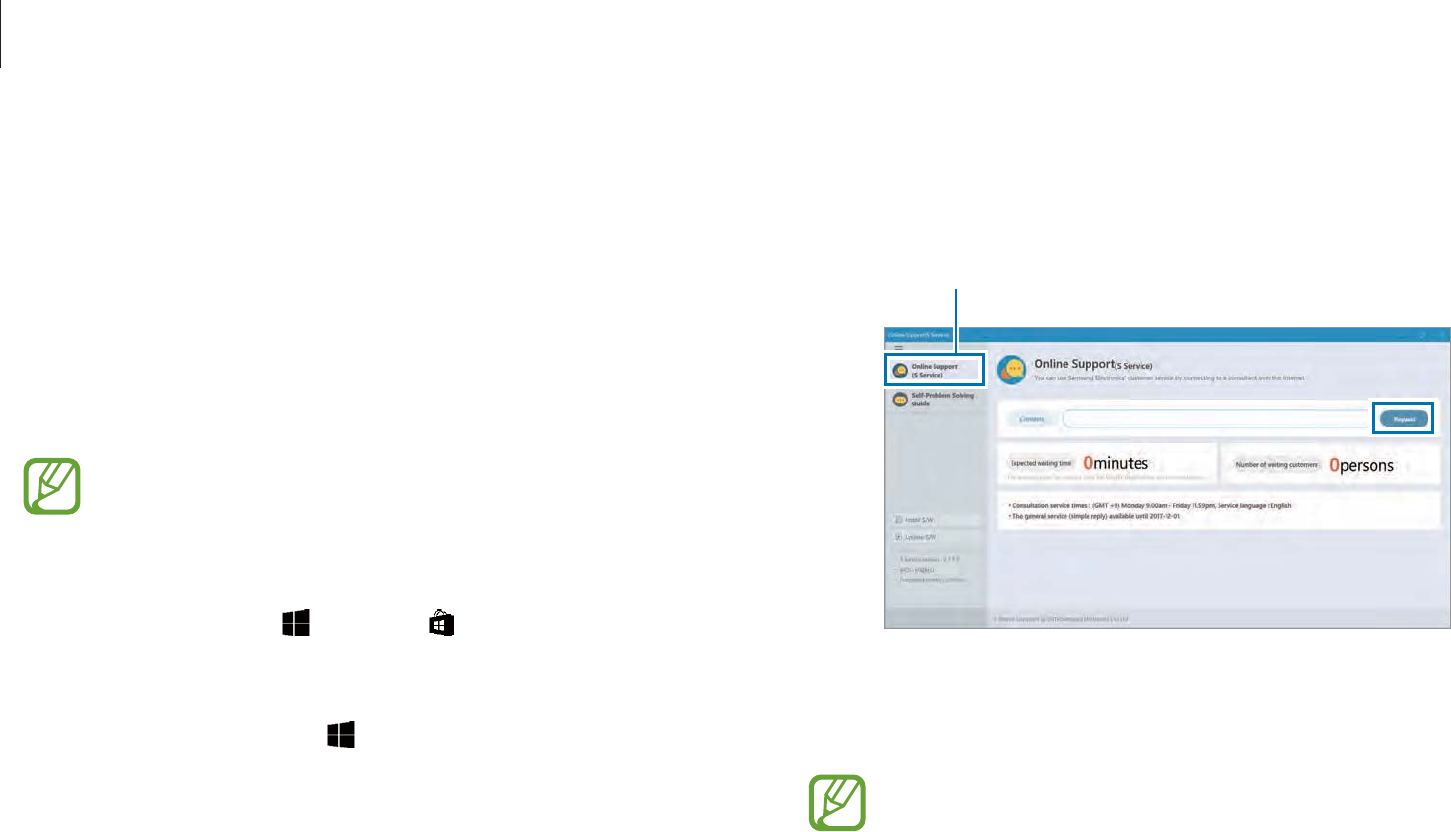
Applications
42
2Select
Online Support (S Service)
on the main page.
Enter the
Contents
and select
Request
.
Online Support (S Service)
3You can speak to a service associate to resolve your
computer’s problems.
Waiting times may vary depending on the network and
number of waiting customers.
Online Support (S Service)
A service associate can resolve any problems you have with your
computer using the online chat and remote control program. You
can receive the help when you are having trouble using Samsung
software.
You can access the online service for free for a certain period of
time after purchasing your computer.
r
Online Support (S Service)
may not be offered or its
version may be different depending on the model you
are using.
r
If
Online Support (S Service)
is not installed, select the
Start button ( )
ĺ
Store
( ) and, search for
S Service
to download it.
1Select the Start button ( )
ĺ
Online Support (S Service)
.

Applications
43
Using Samsung PC Help
1On a smartphone, tap
Samsung PC Help
.
2On the
Samsung PC Help
main screen, select a menu to
display the available content.
r
You may incur additional charges when you access
content.
r
When you register your computer in the
Settings
menu, you can view its information on the Samsung PC
Help app.
Samsung PC Help (Self-help
application)
Use
Samsung PC Help
to access help-related content for
Samsung computers from a smartphone.
Watch the
Samsung PC Help
videos to become familiar with new
functions or to find solutions to problems.
For more information, visit www.samsungpchelp.com.
Installing Samsung PC Help
1On a smartphone, tap
Play Store
and search for
Samsung PC
Help
.
2Tap
INSTALL
ĺ
ACCEPT
to complete the setup.

44
Settings & Upgrade
LCD brightness
Adjust the LCD brightness to reduce eye strain and save power.
1Select the Start button ( )
ĺ
Samsung
ĺ
Samsung
Settings
.
2Select
Display
ĺ
Screen Brightness
and then adjust the level
of brightness.
Changing display mode
Select the optimal screen settings based on your activity.
Some options may not be available depending on the
model.
1Select the Start button ( )
ĺ
Samsung
ĺ
Samsung
Settings
.
2Select
Display
ĺ
Display Color
, and then select an option.
r
Dynamic
: Makes scenes more vivid and clear.
r
Standard
: Appropriate for normal environments and
convenient for most situations.
r
Photo Editing
: Appropriate for viewing photos.
r
Reading
: Appropriate for reading documents.
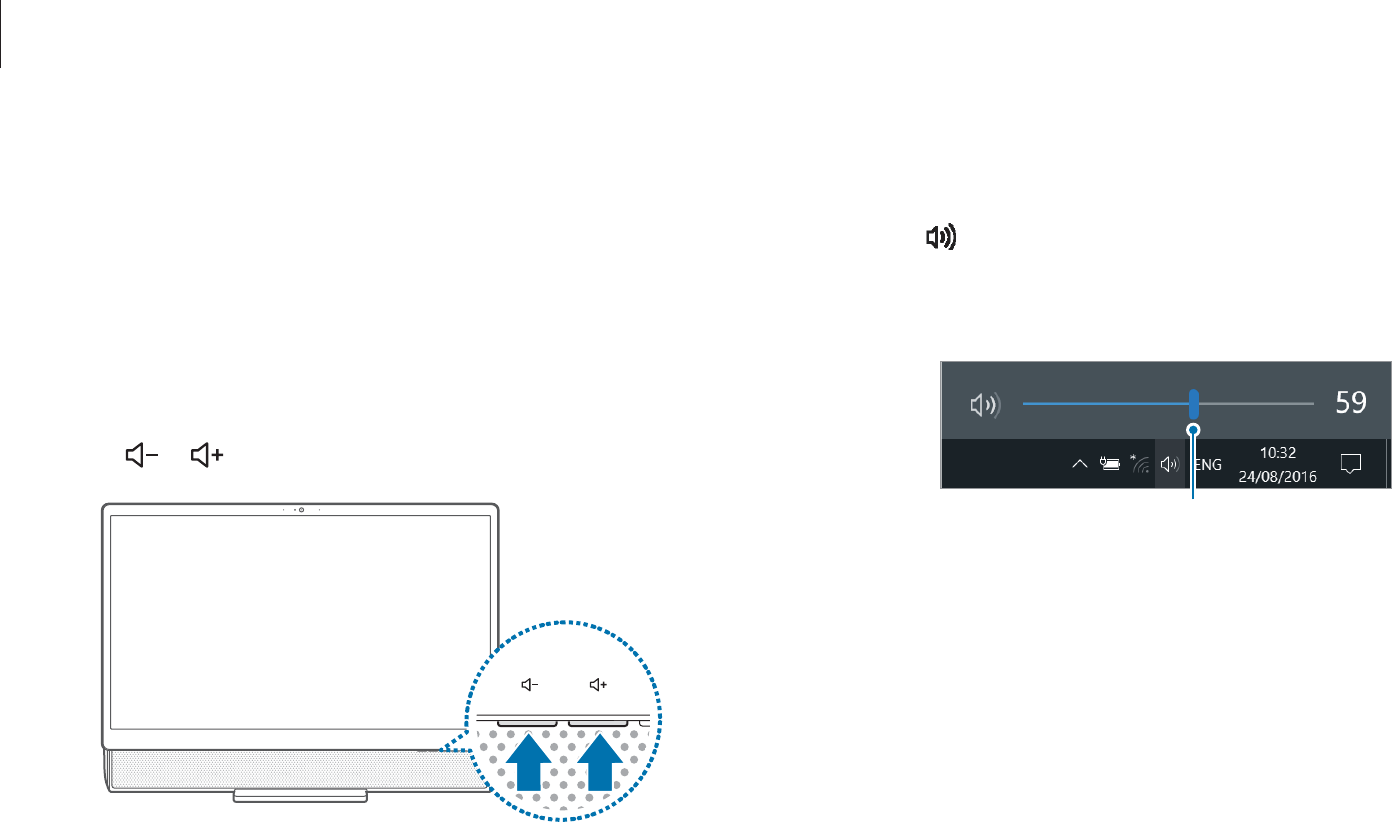
Settings & Upgrade
45
Controlling volume using the taskbar
1Select on the taskbar.
2Drag the adjustment bar to the desired volume.
Volume adjustment bar
Volume
Adjust the system volume or sound volume when playing music
or video.
Controlling volume using the Volume
control buttons
Press the or buttons to adjust the volume.
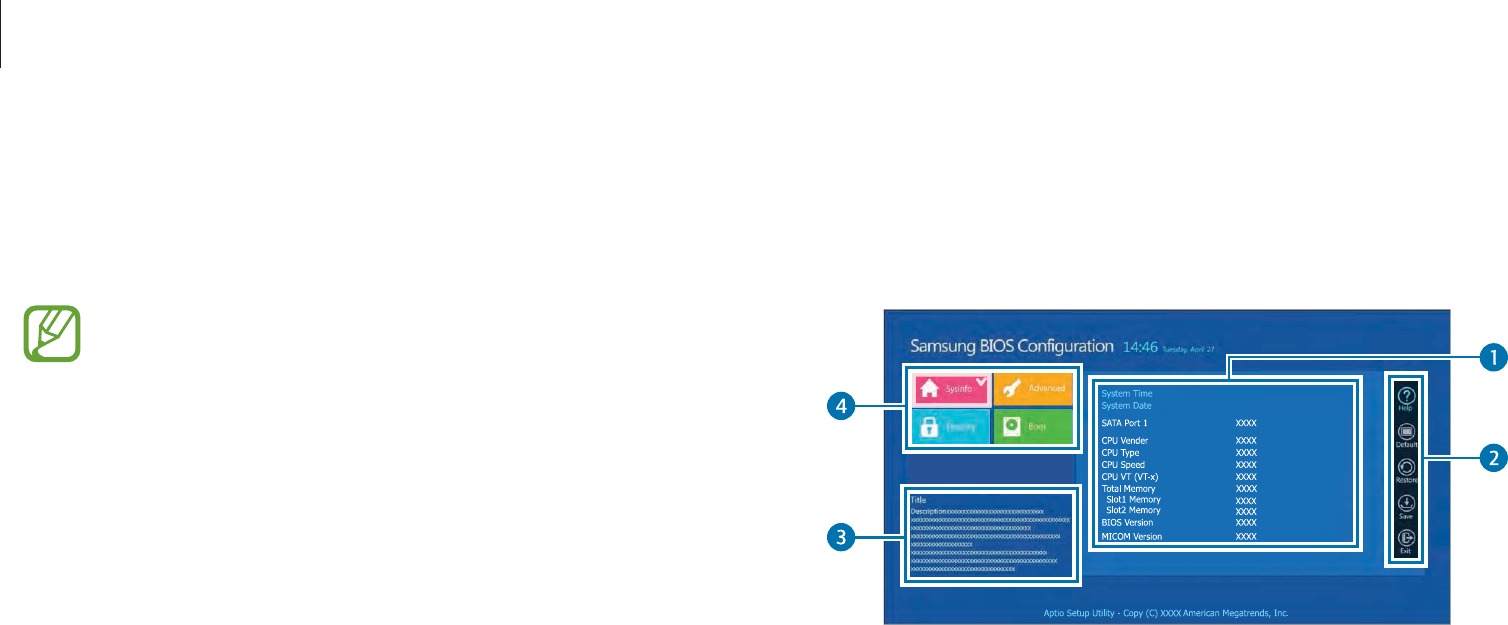
Settings & Upgrade
46
The BIOS screen
The BIOS setup screen appears as shown below.
You can change BIOS settings using the keyboard or mouse.
BIOS (Setup utility)
Define a boot password, change the boot priority, or configure the
installed chipsets.
r
Incorrect settings may cause the system to malfunction
or crash.
r
The BIOS setup screens, menus, and items may appear
differently depending on the model and BIOS version.
r
BIOS setup functions are subject to upgrades.
Entering the BIOS screen
1Turn on the computer.
2Before the Samsung logo appears, press the
F2
key several
times.
r
If the computer is password-protected, press the
F2
key
several times before the password screen appears.
r
If the password screen or the Windows start screen
appears, restart the computer and try again.
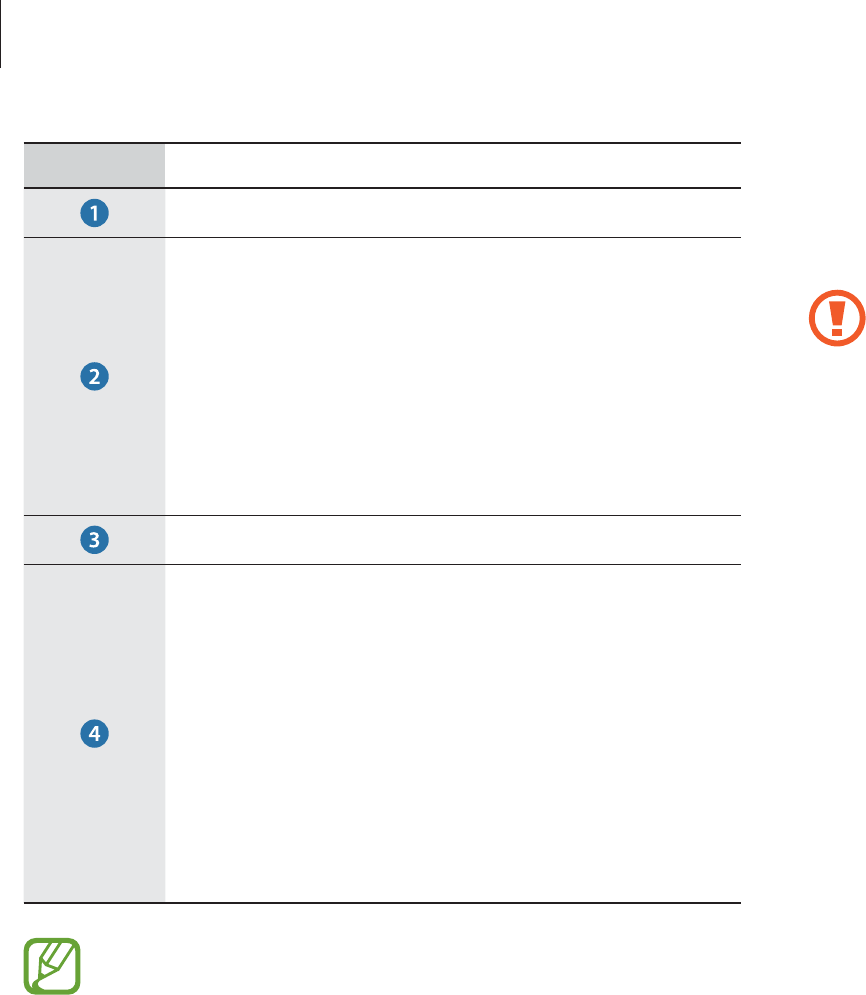
Settings & Upgrade
47
Boot password
Setting a password with the BIOS enhances protection against
viruses and hacking attacks.
r
Do not forget your password or expose it to others.
r
If you forget the
Supervisor Password
or
HDD
Password
, request assistance from the Samsung
Service Center. In this case, a service fee will be charged.
r
If you forget the
User Password
, disable the
Supervisor
Password
, and the
User Password
is also automatically
disabled.
Number Name
r
Setup items
r
Setup tools
–
Help
: View the help for BIOS set up.
–
Default
: Return to the default settings.
–
Restore
: Cancel changes.
–
Save
: Save settings.
–
Exit
: Exit BIOS setup.
r
Help
r
Setup menu
–
SysInfo
: View the basic specifications of
the computer.
–
Advanced
: Configure the chipsets and
additional functions.
–
Security
: Configure security functions.
–
Boot
: Configure peripherals and boot-
related settings.
The BIOS setup screen appears only in English.

Settings & Upgrade
48
Setting a boot password
1Turn on the computer.
2Before the Samsung logo appears, press the
F2
key several
times.
3Access the
Security
menu.
4Select a password type (
Supervisor Password
,
User
Password
, or
HDD Password
).
If you cannot select an item or the
HDD Password Frozen
message appears, turn off the computer and turn it on again.
Then, press the
F2
key several times before the Samsung logo
appears to enter the BIOS setup screen.
Setting passwords
There are three password settings available:
Supervisor Password
,
User Password
, and
HDD Password
.
r
Supervisor Password
(low security level): This password is
required when turning on the computer or entering the BIOS
setup.
r
User Password
(low security level): This password is required
to enter the BIOS setup. This password will be deactivated
automatically if the
Supervisor Password
is disabled.
r
HDD Password
(high security level): This password is required
to access the hard disk drive (HDD) from another computer.
This password may not be supported, depending on the
model.

Settings & Upgrade
49
Removing a password
1Turn on the computer.
2Before the Samsung logo appears, press the
F2
key several
times.
3Access the
Security
menu.
4Select a password type (
Supervisor Password
,
User
Password
, or
HDD Password
).
5Enter the current password and select
Ok
.
6Without entering any characters, select
Ok
ĺ
Ok
.
7Select
Save
ĺ
Ok
to save and restart.
For some models, to cancel the password, select
Cancel
in
the Setup Notice window.
5Enter a password and select
Ok
.
The password can be up to 20 characters.
6Enter the password again to confirm it and select
Ok
.
7Select
Save
ĺ
Ok
to save and restart.
r
To enable the
Password On Boot
option, set a
Supervisor Password
and enter the password when
starting up the computer.
r
To change the
HDD Password
after setting it, restart
the computer.
r
For some models, if the password entered message
appears in the Setup Notice window, select
Ok
to
complete the setup.

Settings & Upgrade
50
Boot priority
Change the boot priority from the BIOS setup.
1Turn on the computer.
2Before the Samsung logo appears, press the
F2
key several
times.
3Access the
Boot
menu.
4Select
Boot Device Priority
.
5Select an option menu to open the list.
6Select an option.
7Select
Save
ĺ
Ok
to save and restart.
Select
Exit
ĺ
Ok
to restart without saving the changes.

51
Troubleshooting
Samsung Recovery
When a problem occurs with the computer, it is easy to restore
the computer back to the factory default settings by using the
Samsung Recovery
application (Recovery/Backup). It is also
possible to restore the computer to a previously backed up point.
Back up important data regularly before a problem occurs with
the computer.
r
The
Samsung Recovery
application may not be
provided in models with less than 64 GB of storage. If
you cannot access the Samsung Recovery application,
refer to Windows recovery function.
r
Some functions may differ or may be unavailable
depending on the version. Refer to the application’s
help information.
r
Run the
Samsung Recovery
application with
administrator privileges.
r
The
Samsung Recovery
application (Recovery/Backup)
is not available when using CD/DVD drives.
r
Recovering the computer erases the data or
applications saved after a backup point. Therefore, back
up important data regularly before a problem occurs
with the computer.
r
When you launch the application for the first time, read
and accept the Terms and Conditions when they display
on the screen.
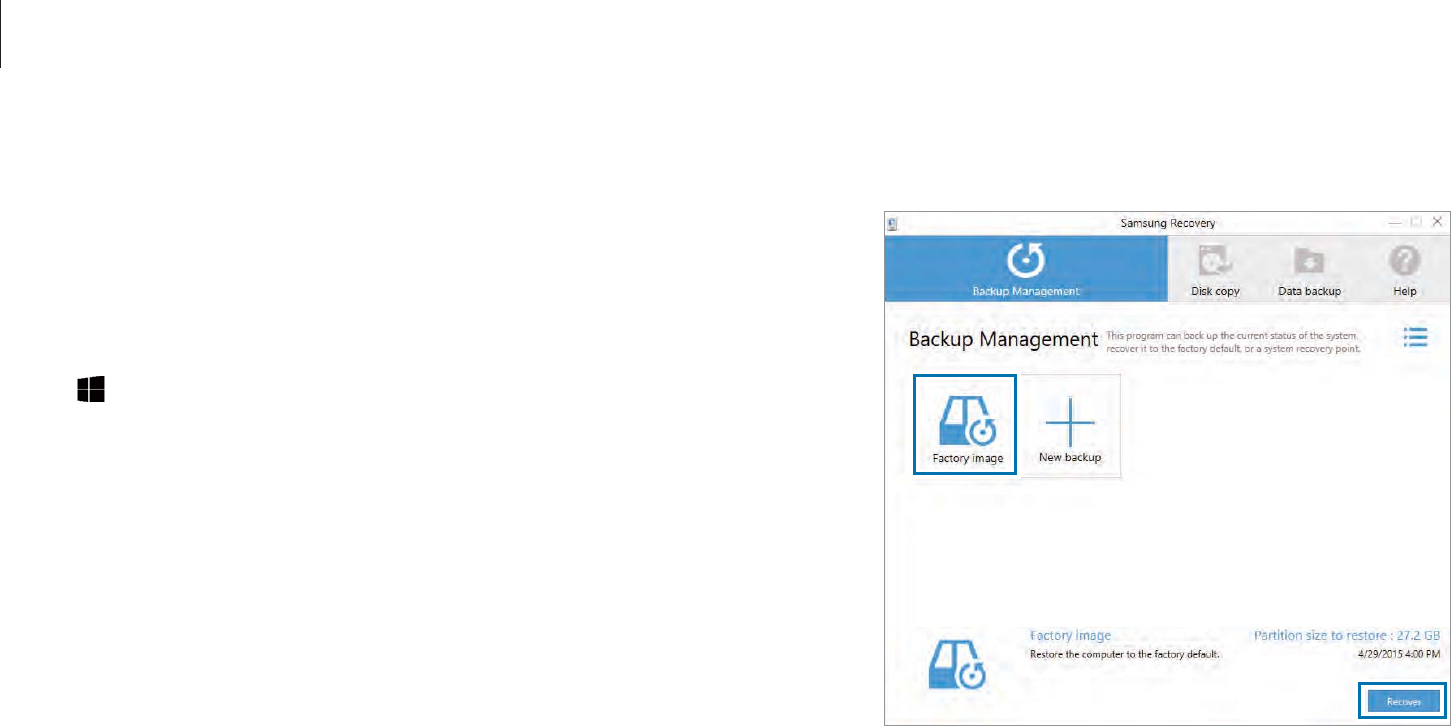
Troubleshooting
52
2Select
Backup Management
ĺ
Factory image
ĺ
Recover
.
Recovering to factory default
You can restore the computer to its factory default settings. If
necessary, back up important data to an external storage device
before restoring the system. See Backing up the current system.
1
When the computer starts Windows
: Select the Start button
()
ĺ
Samsung
ĺ
Samsung Recovery
.
When the computer does not start Windows
: Turn on the
computer and press the
F4
key several times before the
Samsung logo appears.
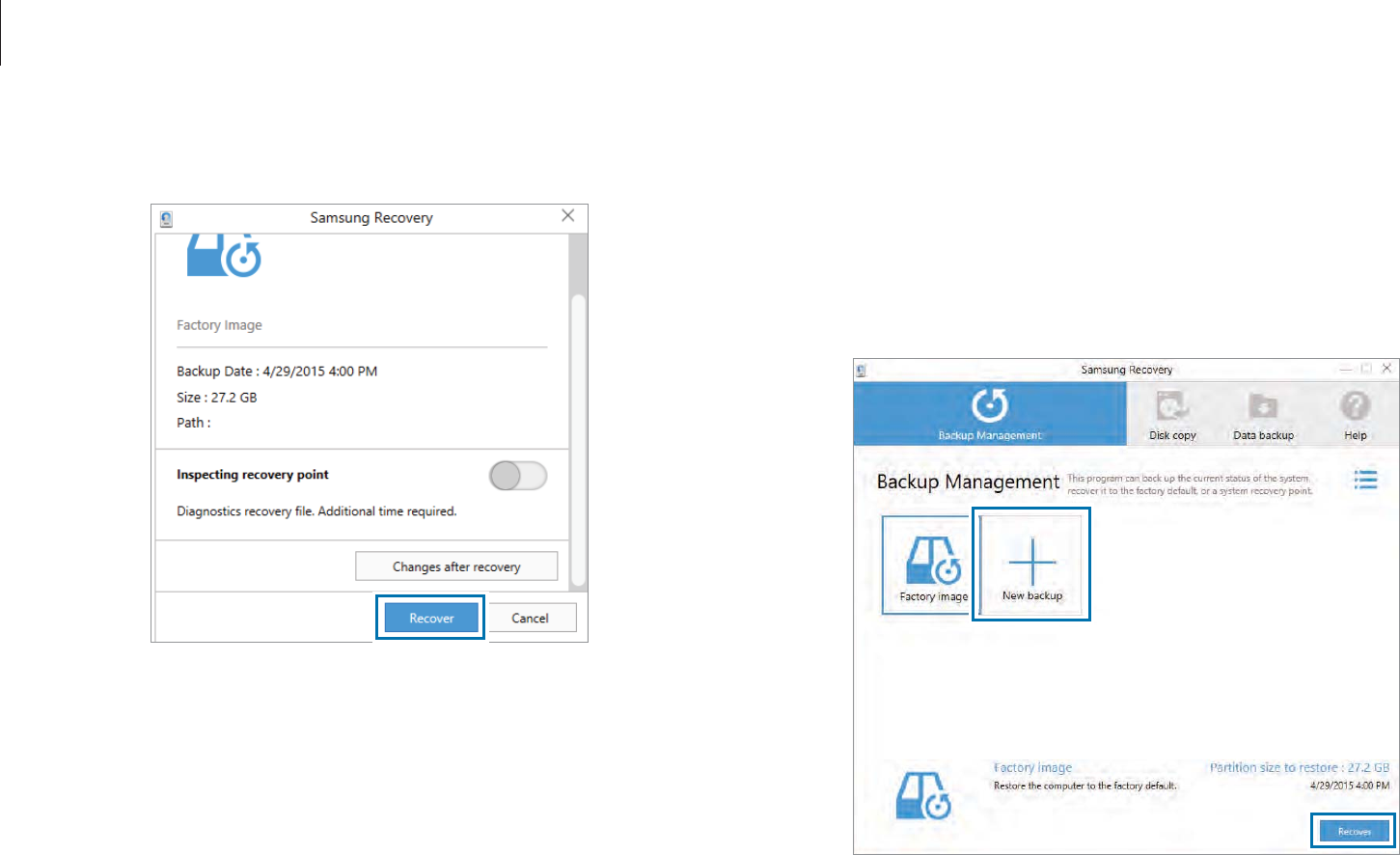
Troubleshooting
53
Backing up the current system
Back up important data to an alternate internal drive or an
external storage device regularly to prevent data loss.
1Select
Backup Management
ĺ
New backup
.
3Select
Recover
.
4Follow the on-screen instructions to complete the recovery.
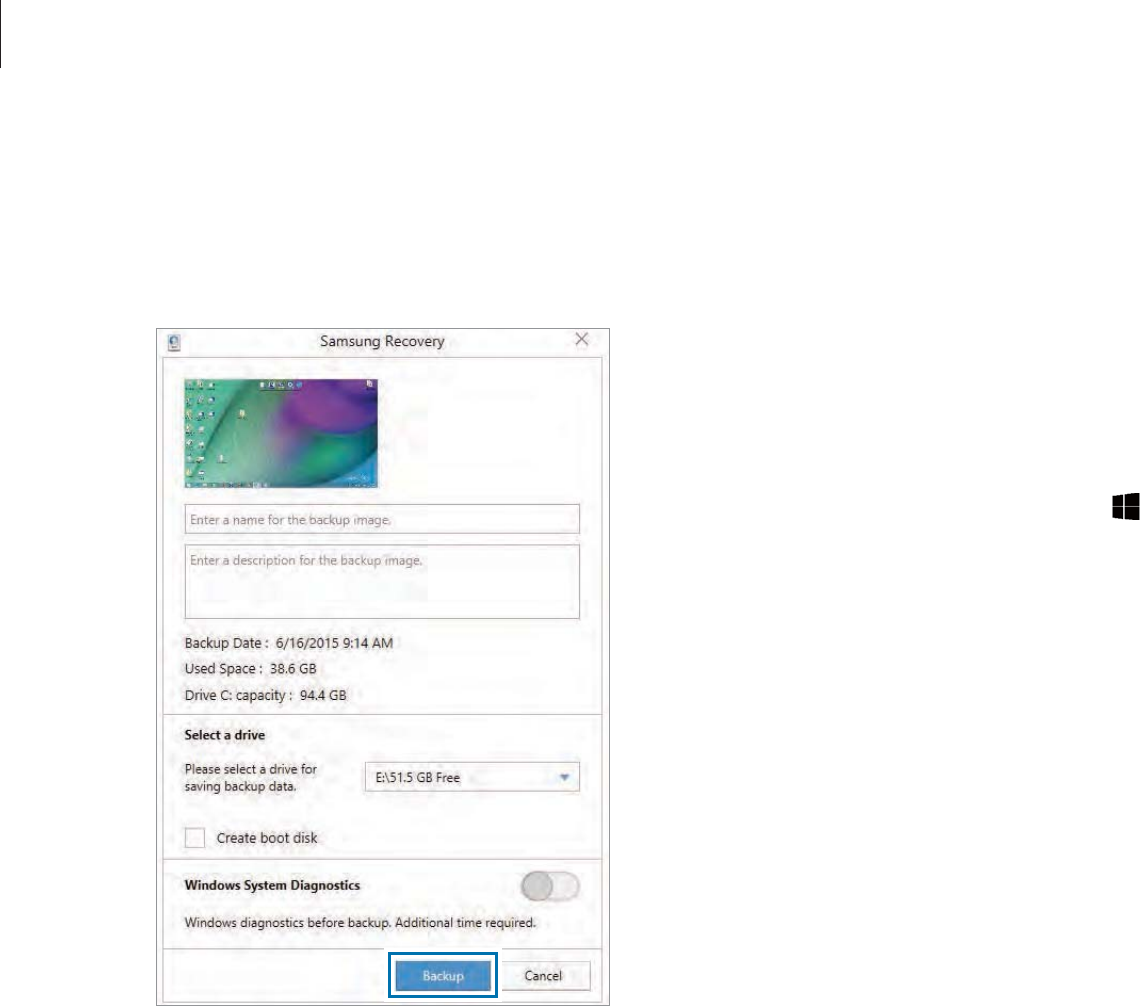
Troubleshooting
54
3Follow the on-screen instructions to complete the backup.
Recovering after a backup
Select a backup point saved on an alternate internal drive or an
external storage device to recover the computer to that point.
1When backing up to an external storage device, connect the
device to the computer.
2Select the Start button ( )
ĺ
Samsung
ĺ
Samsung
Recovery
.
2Select a drive from the drive list
ĺ
Backup
.
r
When backing up to an external storage device, connect
the device to the computer and then select the external
drive.
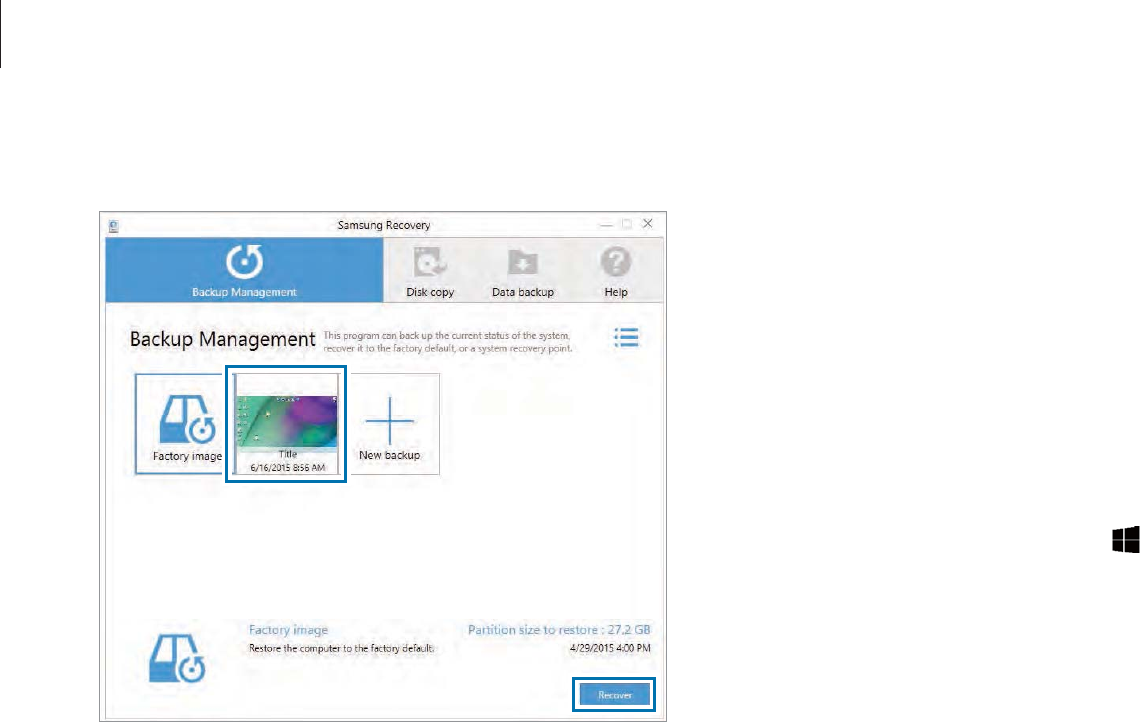
Troubleshooting
55
Copying the drive (making a disk image)
To replace the drive, move the data to the new drive by making a
disk image. The new drive must be large enough to hold the data
from the current drive.
Purchase an external hard drive connector separately to connect
the new drive to the computer.
1Connect the new drive to the computer with an external hard
drive connector.
2Select the Start button ( )
ĺ
Samsung
ĺ
Samsung
Recovery
.
3Select
Disk copy
.
3Select
Backup Management
ĺ
a backup image
ĺ
Recover
.
4Follow the on-screen instructions to complete data recovery.
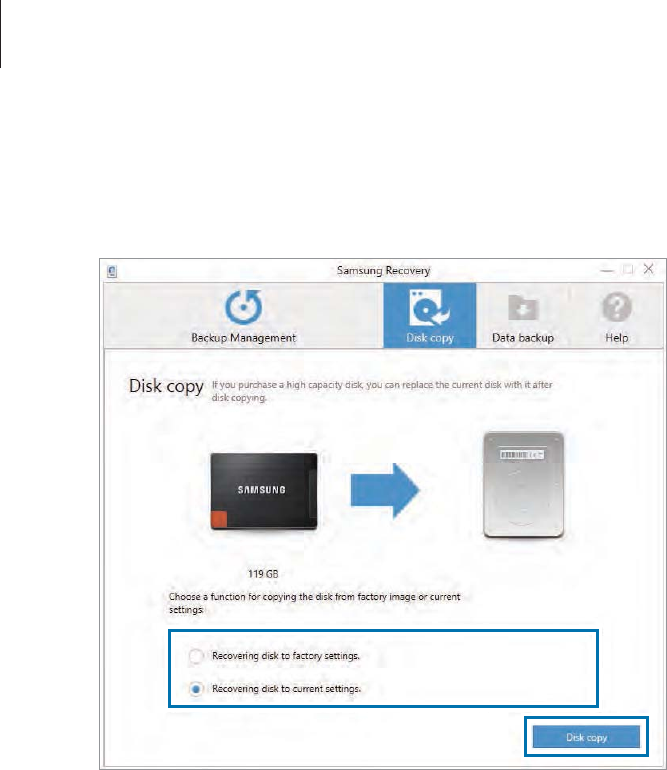
Troubleshooting
56
4Select a backup option
ĺ
Disk copy
.
The data on the disk is copied to the new disk.

Troubleshooting
57
Q&A
When experiencing problems with the computer, try these
solutions.
Windows
How can I uninstall an application?
1On the desktop, right-click the Start button ( ) and select
Control Panel
ĺ
Uninstall a program
.
2On the list, right-click an application to delete, and then select
Uninstall
.
Windows recovery function
If the
Samsung Recovery
application is not supported by the
computer, reinstall Windows using the recovery function of
Windows.
Reinstalling Windows will erase all data saved on the
computer. Back up application and personal data to an
external storage device before reinstalling Windows.
1Select the Start button ( )
ĺ
ĺ
Update & security
ĺ
Recovery
.
2Select
Reset this PC
ĺ
Get started
.
3Select
Keep my files
or
Remove everything
.
After the system is recovered, select the Start button
()
ĺ
Samsung
ĺ
Samsung Update
to install the
required Samsung applications.

Troubleshooting
58
Samsung Recovery
What is a Recovery area?
The computer has an additional partition for restoring data or
saving backup files (only for models with the
Samsung Recovery
application). This partition is called a Recovery area and it includes
a recovery image comprised of the operating system and
applications.
How can I start my computer in DOS?
To start the computer in DOS via a USB device:
1Turn on the computer.
2Before the Samsung logo appears, press the
F2
key several
times.
3Select the
Boot
menu.
4Select
Boot Device Priority
.
5Select the USB device for
Boot Option #1
.
6Set
Fast BIOS Mode
to
Off
.
7Set
Secure Boot Control
to
Off
.
8Set
OS Mode Selection
to
CSM OS
.
9Select
Save
ĺ
Ok
to save and restart.

Troubleshooting
59
What is a recovery image?
This refers to the operating system, drivers, and software that are
converted to a data image. It is required to recover the computer
and is embedded in the computer’s HDD. However, this is not
provided for storage devices where the capacity is less than 64 GB,
due to their small capacities.
How can I restore a computer that does not have the
Samsung Recovery application?
Restore the computer with the recovery function provided by
Windows. Refer to the Recover Functionality item in the help for
more details.
Why is the capacity representation of the hard disk
drive (HDD) in Windows different from the product
specifications?
The capacity of the storage device (HDD or SSD) of the
manufacturer is calculated assuming that 1 KB = 1,000 Bytes.
However, the operating system (Windows) calculates the storage
device capacity assuming that 1 KB = 1,024 Bytes, and therefore
the capacity representation of the HDD in Windows is smaller than
the actual capacity. The capacity representation in Windows may
be smaller than the actual capacity because some applications
occupy a certain area of the HDD outside of Windows.
For models with the
Samsung Recovery
application, the HDD
capacity representation in Windows may be smaller than the
actual capacity because the
Samsung Recovery
application
uses a hidden area of 5–20 GB of the HDD to save the recovery
image, and that hidden area is not counted towards the total
size available to Windows. The size of the
Samsung Recovery
application varies by model.

60
Appendix
Product specifications
The system specifications may differ depending on the derived
model. For detailed system specifications, refer to the product
catalog.
Item Specification
Operating
environment
r
Temperature: -5–40 °C for storage,
10–35 °C when operating
r
Humidity: 5–90 % for storage,
20–80 % when operating
AC/DC rating
r
Input: 100–240 VAC, 50–60 Hz
r
Output: 19 VDC, 4.74 A
PC rating
r
19 VDC, 4.74 A (90 W)
r
Optional components may not be provided or different
components may be provided depending on the
model.
r
The system specifications are subject to change without
notice.
r
The Storage device capacity of a computer in which
Samsung Recovery
is installed, is smaller than the
product specification.
r
Due to this computer’s design, memory cannot be
added, replaced, or upgraded. Also, additional storage
space cannot be added.
r
The amount of memory that Windows can use may be
smaller than the actual amount of memory available.
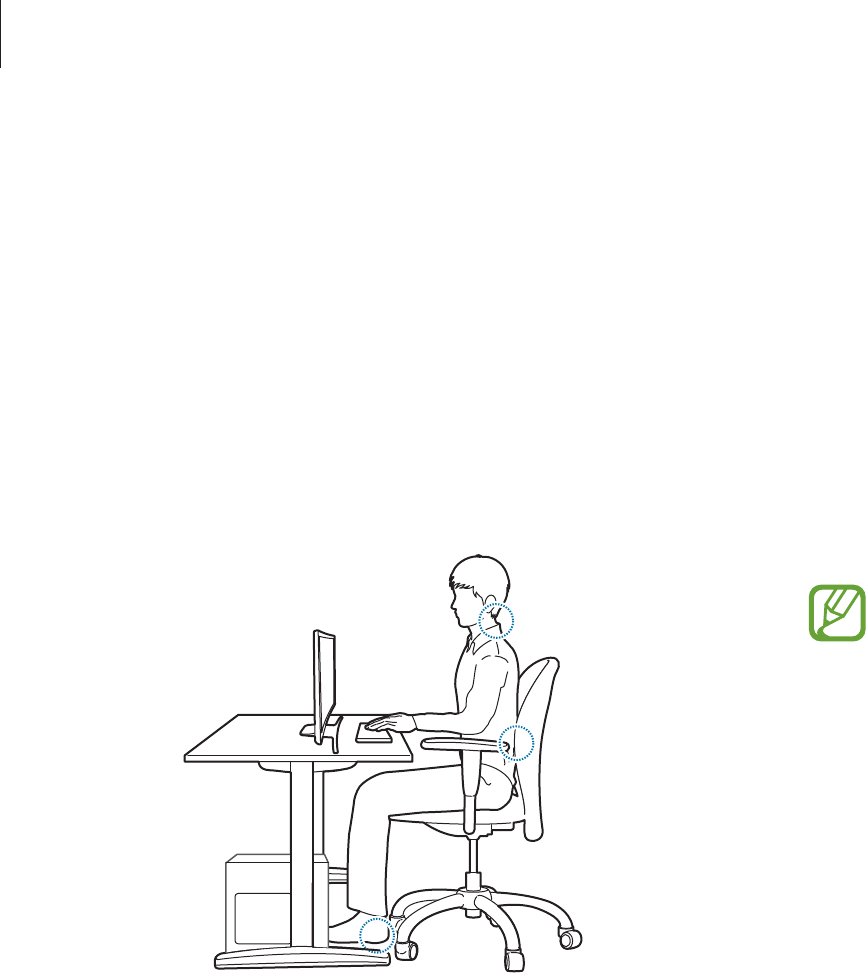
Appendix
61
r
Use an adjustable chair with firm, comfortable support.
r
Adjust the height of your chair so that thighs are horizontal to
the floor and feet are flat on the floor.
r
The back of the chair should support the lower back. Adjust
the backrest to fit your body properly.
r
Sit back fully in your chair and straighten the back and neck.
Avoid leaning forward or craning your neck toward the
computer screen.
r
Avoid using the computer while lying down or on your lap.
If the computer’s temperature increases, there is a danger of
burn injury.
r
The instructions in this manual have been prepared
so that they can be applied to the range of needs of
general users. If the user is not included in the range,
the recommendations should be applied according to
the user’s needs.
r
Images may differ from actual products.
Ergonomic tips
Maintaining the proper posture during computer use is very
important to prevent physical injury. Improper or prolonged
keyboard use may result in repetitive strain injury. Viewing the
monitor screen for extended periods of time may result in eye
strain. Therefore, please follow these guidelines carefully when
setting up and using the computer.
Back and neck
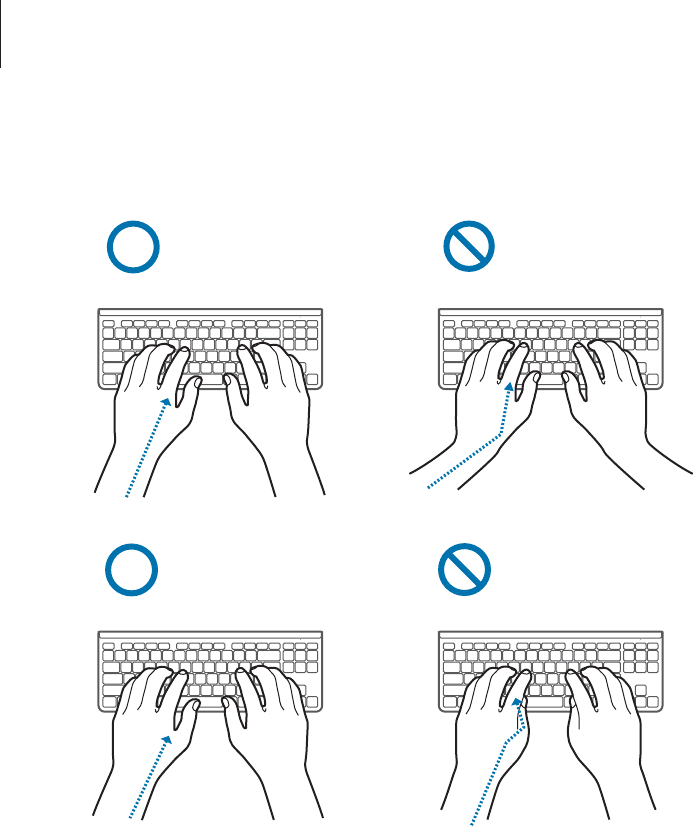
Appendix
62
r
When using the keyboard and touchpad, the shoulders
should be relaxed. The upper arm and forearm should form an
angle that is slightly greater than a right angle, with the wrist
and hand in almost a straight line.
r
Use a light touch when typing or using the touchpad and
keep the hands and fingers relaxed. Avoid rolling the thumbs
under your palms or supporting the wrists on the desk while
typing.
r
Use an external keyboard and mouse when using the
computer for long periods. When using an external keyboard
and mouse, position the devices at the same height as the
computer and within comfortable reach.
Arms and hands
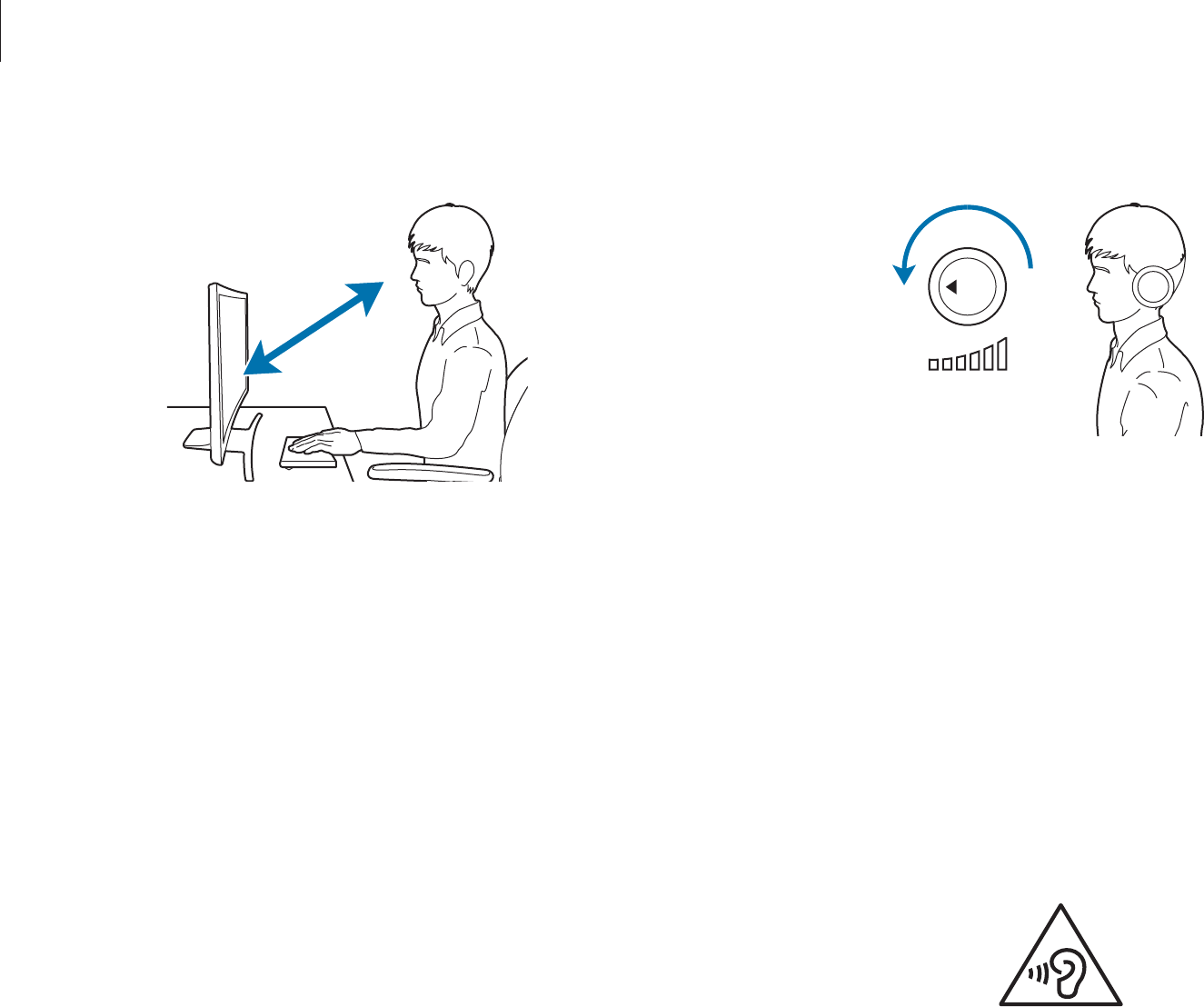
Appendix
63
Hearing and volume control
VOLUME
Check your volume!
r
Ensure that the volume is not too loud before using the
headset or earpiece. Excessive exposure to loud sounds can
cause hearing damage.
r
Always turn the volume down before plugging the earphones
into an audio source and use only the minimum volume
setting necessary to hear your conversation or music.
r
Avoid using headphones for long periods of time.
r
Default audio settings can be changed by software and driver
updates without your knowledge. Always recheck equalizer
and volume settings before listening to audio.
r
To prevent possible hearing damage, do not listen at high
volume levels for long periods.
Eye position and display illumination
50 cm
r
Position the screen at least 50 cm away from your eyes.
r
Adjust the height of the screen so that its top edge is equal to
or just below the level of your eyes.
r
Avoid setting the screen’s brightness settings excessively high.
r
Keep the screen clean.
r
If wearing glasses, clean them before using the computer.
r
When referring to printed content while typing, use a static
paper holder to hold the paper at about the same height as
the monitor.

Appendix
64
r
If anyone related to you has experienced seizures or blackouts
while using a similar product, consult a physician before using
the computer.
r
If you feel discomfort, such as a muscle spasm, or disoriented,
stop using the computer immediately and consult a physician.
r
To prevent eye strain, take frequent breaks while using the
computer.
Reduce the risk of repetitive motion injuries.
When you repetitively perform actions, such as pressing keys,
drawing characters on a touch screen with your fingers, or
playing games, you may experience occasional discomfort in your
hands, neck, shoulders, or other parts of your body. When using
your computer for extended periods, hold the computer with a
relaxed grip, press the keys lightly, and take frequent breaks. If you
continue to have discomfort during or after such use, stop using
the computer and consult a physician.
Operating conditions
r
Take at least a 10 minute break every hour.
r
Avoid using the computer in dark locations. Use the computer
with as much ambient light as you would when reading a
book.
r
Indirect illumination is recommended. Use a curtain to
prevent reflections and glare on the screen.
r
While operating a computer and talking on the phone, use a
headset. Using the computer while holding a phone on your
shoulder or with your neck may lead to muscle strain or injury.
r
Keep frequently used items within reach.
r
Only use the computer within the temperature and humidity
ranges specified in this manual.
Use caution when exposed to flashing lights.
r
While using your computer, leave some lights on in the room
and do not hold the screen too close to your eyes.
r
Seizures or blackouts can occur when you are exposed to
flashing lights while watching videos or playing Flash-based
games for extended periods. If you feel any discomfort, stop
using the computer immediately.

Appendix
65
Power related
Handle the power cord with care.
r
Do not touch with wet hands.
r
Do not use a damaged power cord.
r
Do not overload a multi-outlet or an extension cord beyond
the specified voltage/current capacity.
r
Firmly insert the power cable into the AC adapter.
r
Do not unplug the power cord by pulling on the cable.
r
Unplug the wall-mount AC adapter (integrated plug and
power adapter) from the wall outlet while holding the body
and pulling it in the direction of the arrow.
Failure to do so may result in electric shock or fire.
Connect the power cord to the AC adapter firmly.
An improper connection may result in a fire.
Use the approved adapter or cable included in the product box.
If you use the unapproved adapter or cable, it cause the damage
or malfunction of the computer.
Safety precautions
For your safety and security and to prevent damage, carefully read
the following safety instructions. This ’Safety precautions’ relate to
computer use. Some of the content may be not applicable to your
computer.
r
Since this is commonly applied to Samsung Computers,
some pictures may differ from actual products.
r
The product mentioned in this guide refers to all items
supplied with the computer including the battery,
the AC adapter, and all other Samsung-provided
accessories.
Warning
Failure to follow the instructions marked with this symbol may
result in physical injury or fatality.
DT/AIO UM Rev 4.0

Appendix
66
Battery usage related
Use manufacturer-approved batteries, chargers, accessories,
and supplies.
r
Using generic batteries or chargers may shorten the life of
your product or cause the computer to malfunction. They may
also cause a fire or cause the battery to explode.
r
Samsung cannot be responsible for the user’s safety when
using accessories or supplies that are not approved by
Samsung.
Take care not to allow metal objects such as a key or clip to
touch the battery terminal (metal parts).
This may cause excessive current and result in fire, burns, or
damage to the battery.
If the computer or the computer battery leaks, emits strange
odors, or swells, immediately stop using the computer and
contact a Samsung Service Center.
Failure to do so may result in an explosion or fire.
Replace a run-down battery with a new, Samsung-approved
battery.
Use only properly earthed electric sockets or extension cords.
Unearthed electric sockets or extension cords may cause electric
shock. Any connection to unearthed electric sockets or extension
cords may produce an electric field from a current leak.
If water or other substances enters the product, disconnect the
power cable and contact a Samsung Service Center.
Failure to do so may result in electric shock or fire due to the
malfunction of the inner part.
Do not let dust accumulate on the power cord or the electric
socket. Regularly wipe the power cord and the electric socket
with a dry cloth.
Failure to do so may result in electric shock or fire.
Do not bend or damage the power cable or the AC adapter with
a heavy or sharp-edged object.
A damaged cable or cord may result in electric shock or fire.
Keep the battery, AC adapter, and the power cord away from
infants, children, and pets.
Failure to do so may result in electric shock or damage.

Appendix
67
To avoid suffocation, keep the plastic bag away from infants and
children.
Putting a plastic bag over the head may result in suffocation.
Never heat the computer (or the battery) or put the computer
(or the battery) into a fire.
Failure to do so may result in an explosion or fire.
Before cleaning the computer, disconnect all the cables that are
connected to the computer.
Failure to do so may result in electric shock or fire.
Keep the computer away from water or liquid.
Water or liquid entering the computer may short-circuit the
computer, resulting in electric shock or fire.
If the computer is dropped or broken, disconnect the power
cord and contact a Samsung Service Center.
Using a broken computer may result in electric shock or fire.
Do not touch the computer’s surface or the vents for extended
periods while the computer is on.
Contact with the vent or the surface for extended periods may
result in low-temperature burns, such as redness on the skin.
Dispose of worn-out batteries properly.
r
There is a danger of fire or explosion.
r
The battery disposal method may differ depending on
your country and region. Dispose of the used battery in an
appropriate way.
When removing the real time clock (RTC) battery, keep it away
from infants and children.
If a child swallows the battery, the child may suffocate. If this
happens, immediately contact a doctor.
Usage related
Do not use the computer on heated floors or electric pads, or
on beds, blankets, or cushions that block the ventilation of the
computer.
A blocked vent causes the computer to overheat, resulting in an
explosion, fire, burns, or computer malfunction.
Do not use the computer in hot or humid locations, such as a
bathroom, sauna, or inside a car during summer.
Failure to do so may result in computer malfunction or electric
shock.
The computer can be used in locations with an ambient
temperature of 10 °C to 35 °C and a relative humidity of 20 % to
80 %RH.

Appendix
68
Do not place heavy objects on the product.
This may cause a problem with the computer. In addition, the
object may fall and cause injury or damage the computer.
Properly shut down, disconnect and secure the computer cables
before moving it.
Failure to do so may damage the computer or cause someone to
trip over a loose cable.
Usage related
Do not use the pen for unintended purposes, such as poking
the body like eyes or ears and do not put it in your mouth.
Doing so may result in physical injury.
Do not place a candle, light cigar, etc. over or on the product.
There is a danger of fire.
Make sure to have the product tested by a safety service
engineer after repairing the product.
Using a repaired product without testing it for safety may cause an
electric shock or fire.
Caution
Failure to follow instructions marked with this symbol may result
in minor physical injury or damage to the computer.
Installation related
Do not block the ports (holes), vents, etc. of the product and do
not insert objects.
Damage to a component within the computer may cause electric
shock or fire.
When using the computer on its side, ensure the vents are clear
and facing upwards.
Failure to do so, may cause the internal temperature of the
computer to rise and the computer to malfunction or halt.
Keep the computer’s vents at least 15 cm away from walls and
other objects.
Failure to do so may result in physical injury.
Do not place or use the computer on slanted or vibrating
surfaces.
Failure to do so may result in computer malfunction or damage.

Appendix
69
If the product emits smoke or there is a burning smell,
disconnect the power plug from the wall outlet and contact a
Samsung Service Center immediately.
There is a danger of fire.
Do not use damaged or illegally modified CDs.
There is a danger of damaging the product or personal injury.
Do not insert the fingers into the ports (holes), card slot, or
vents.
There is a danger of injury or electric shock.
Use recommended computer cleansing solutions when
cleaning the product and only use the computer when it is
completely dry.
Failure to do so may result in electric shock or fire.
You should not use a paper clip to perform an emergency
disc ejection while the disc is in motion. Make sure to use the
emergency disc eject method only when the Optical Disc Drive
has stopped.
There is a danger of injury.
In case of lightning, immediately turn the system off, disconnect
the power cord from the wall outlet and phone line from
modem.
There is a danger of electric shock or fire.
Connect only permitted devices to the connectors or ports of
the computer.
Failure to do so may result in an electric shock or fire.
Do not press the eject button while the CD-ROM drive is in
operation.
You might lose data and the disc might be suddenly ejected and
could cause an injury.
Do not drop or hit the computer against anything.
Failure to do so may result in physical injury or computer
malfunction.
Do not allow the antenna and a source of electricity, such as a
socket outlet, to come into contact.
There is a danger of electric shock.
When handling computer parts, follow the instructions on the
manual supplied with the parts.
Failure to do so may result in damage to the product.

Appendix
70
Do not use your computer in a hospital or on an aircraft that can
be interfered with by radio frequency.
r
Avoid using your computer within a 15 cm range of a
pacemaker, if possible, as your computer can interfere with
the pacemaker.
r
To minimize possible interference with a pacemaker, use your
computer only on the side of your body that is opposite the
pacemaker.
r
If you use medical equipment, contact the equipment
manufacturer before using your computer to determine
whether or not the equipment will be affected by radio
frequencies emitted by the computer.
r
When in a hospital, turn off your computer and follow all
hospital regulations. Radio frequencies emitted from the
computer may affect medical equipment.
Do not place your face close to the Optical Disc Drive tray when
it is operating.
There is a danger of injury due to an abrupt ejection.
Do not use the product if it is cracked or broken.
Broken glass or acrylic could cause injury to your hands and face.
Take the device to a Samsung Service Center to have it repaired.
When using wireless communication (LAN, Bluetooth, etc.)
always follow applicable instructions. For example, airlines and
hospitals have strict requirements.
Avoid exposing a drive to magnetic fields. Security devices
with magnetic fields include airport walk-through devices
and security wands. The airport security devices that check
carry-on luggage, such as conveyor belts, use X-rays instead of
magnetism and will not damage a drive.
Keep the computer away from magnetic material.
r
Magnetic materials may cause computer malfunction.
r
To avoid damaging the computer or magnetic stripe cards,
such as credit cards, keep magnetic stripe cards away from the
computer.

Appendix
71
Make sure to close the computer cover before connecting the
power after a reassembly.
There is a danger of electric shock if your body touches an internal
part.
Never disassemble or repair the product by yourself.
There is a danger of accident. Use authorized Samsung Service
Center.
To connect a device that is not manufactured or authorized
by Samsung, enquire at a Samsung Service Center before
connecting the device.
There is a danger of damaging the product.
Storage and movement related
Do not operate or look at the computer while driving a vehicle.
There is a danger of a traffic accident. Please concentrate on
driving.
Upgrade Related
Do not attempt to upgrade the computer, unless you are
qualified. Otherwise, contact a Samsung Service Center or an
authorized technician.
Follow the specified instructions contained in the manual for
user maintenance. Do not disassemble any other parts by
yourself.
Failure to do so may result in computer malfunction, electric
shock, or fire.
Take care when touching the product or parts.
The computer may be damaged or you may be injured.
Do not disassemble the power supply unit in any circumstances.
Failure to do so may result in electric shock, fire, or an explosion.
Shut down the computer and disconnect all cables before
disassembling the computer.
Failure to do so may cause electric shock.

Appendix
72
LCD bad pixels
Samsung observes strict specifications regarding the quality
and reliability of the LCD. However, there is a small chance that
a few pixels may be bad. A large number of bad pixels can cause
problems with the display, but a small number of bad pixels
does not generally affect computer performance.
Samsung’s quality standards for bad pixels are as follows:
r
Bright dot
: 2 or fewer
r
Black dot
: 4 or fewer
r
Combination (bright and dark)
: 4 or fewer
Clean the LCD screen with a soft cloth dampened with
computer cleansing detergent.
Do not use excessive force. Doing so may damage the LCD screen.
Cautions on preventing data loss (hard disk
management)
Take care not to damage the data on a storage device.
r
Subjecting the device to physical impacts may result in data
loss.
r
The data may be lost when the computer is turned off or reset
by a power failure while the storage device is operating.
r
The data may be lost and irrecoverable due to a computer
virus.
r
The data may be lost if the power is turned off while running
an application.
r
Samsung is not liable for any loss of data on the storage
device.
To prevent data loss due to damage to the hard disk drive,
please back up the data frequently.

Appendix
73
Setting up the system
r
Read and follow all instructions marked on the product and
in the documentation before operating the system. Retain all
safety and operating instructions for future use.
r
Do not use this product near water or a heat source such as a
radiator.
r
Set up the system on a stable work surface.
r
The product should be operated only with the type of power
source indicated on the rating label.
r
Ensure that the electrical outlet to power the equipment is
easily accessible in case of fire or short circuit.
r
If the computer has a voltage selector switch, make sure that
the switch is in the proper position for your area.
r
Openings in the computer case are provided for ventilation.
Do not block or cover these openings. Make sure you provide
adequate space, at least 6 inches (15 cm), around the system
for ventilation when setting up your work area. Never insert
objects of any kind into the computer ventilation openings.
Important safety information
Safety instructions
The system is designed and tested to meet the latest standards for
safety of information technology equipment. However, to ensure
safe use of this product, it is important that the safety instructions
marked on the product and in the documentation are followed.
Always follow these instructions to help guard against
personal injury and damage to the system.

Appendix
74
Care during use
r
Do not walk on the power cord or allow anything to rest on it.
r
Do not spill anything on the computer or its components.
The best way to avoid spills is to not eat or drink near the
computer or its components.
r
Some products have a replaceable CMOS battery on the
system board. There is a danger of explosion if the CMOS
battery is replaced incorrectly. Replace the battery with the
same or equivalent type recommended by the manufacturer.
Dispose of batteries according to the manufacturers
instructions. If the CMOS battery requires replacement ensure
that a qualified technician performs the task.
r
When the computer is turned off, a small amount of electrical
current still flows through the computer.
To avoid electrical shock, always unplug all power cables,
remove the battery and modem cables from the wall outlets
before cleaning the system.
r
Ensure that the fan vents on the bottom of the casing are
clear at all times. Do not place the computer on a soft surface,
doing so will block the bottom vents.
r
When using an extension cord with this system, make sure
that the total power rating on the products plugged into the
extension cord does not exceed the extension cord power
rating.
r
For Notebooks with glossy display bezels the user should
consider the placement of the Notebook as the bezel may
cause reflections from surrounding light and bright surfaces.

Appendix
75
Operating instructions
1When installing and operating devices please refer to safety
requirements in the user manual.
2Devices can be used only with the equipment specified in the
technical specifications of the devices.
3If any smell of burning or smoke is detected from the
computer the unit should be switched off and the battery
removed. The unit should be checked by a qualified
technician before reuse.
4Service and repair of devices should be carried out by
authorized service centers.
5Do not allow the portable computer to operate with the base
resting directly on exposed skin for extended periods of time.
The surface temperature of the base will rise during normal
operation (particularly when AC Power is present). Allowing
sustained contact with exposed skin can cause discomfort or
eventually a burn.
r
Unplug the system from the wall outlet and contact a
Samsung Service Center if:
–
The power cord or plug is damaged.
–
Liquid has been spilled into the computer.
–
The computer does not operate properly when the
operating instructions are followed.
–
The computer was dropped or the casing is damaged.
–
The computer performance changes.

Appendix
76
Battery disposal
Do not put rechargeable batteries or products powered by
non-removable rechargeable batteries in the garbage.
Contact the Samsung Service Center for information on how to
dispose of batteries that you cannot use or recharge any longer.
Follow all local regulations when disposing of old batteries.
THERE IS RISK OF EXPLOSION IF BATTERY IS REPLACED BY
AN INCORRECT TYPE.
DISPOSE OF USED BATTERIES ACCORDING TO THE
INSTRUCTIONS.
Replacement parts and
accessories
Use only replacement parts and accessories recommended by
manufacturer.
To reduce the risk of fire, use only No. 26 AWG or larger
telecommunications line cord.
Do not use this product in areas classified as hazardous.
Such areas include patient care areas of medical and
dental facilities, oxygen rich environments, or industrial
areas.

Appendix
77
Connect and disconnect the AC adapter
The socket-outlet shall be installed near the equipment and shall
be easily accessible.
Do not unplug the power cord by pulling the cable only.
Laser safety
All systems equipped with CD or DVD drives comply with the
appropriate safety standards, including IEC 60825-1. The laser
devices in these components are classified as “Class 1 Laser
Products” under a US Department of Health and Human Services
(DHHS) Radiation Performance Standard. Should the unit ever
need servicing, contact an authorized service location.
r
Laser Safety Note: Use of controls or adjustments or
performance of procedures other than those specified
in this manual may result in hazardous radiation
exposure. To prevent exposure to laser beams, do not
try to open the enclosure of a CD or DVD drive.
r
Class 1M laser radiation when operating part is open.
Do not view directly with optical instruments.
r
Class 3B invisible laser radiation when open.
Avoid exposure to the beam.

Appendix
78
General requirements
The requirements listed below are applicable to all countries:
r
All power cord sets must be approved by an acceptable
accredited agency responsible for evaluation in the country
where the power cord set will be used.
r
The power cord set must have a minimum current capacity
of 7A and a nominal voltage rating of 125 or 250 volts AC, as
required by each country’s power system (USA only).
r
The appliance coupler must meet the mechanical
configuration of an EN 60 320/IEC 320 Standard Sheet C7
(or C5) connector, for mating with appliance inlet on the
computer.
Power cord requirements
The power cord set (all plug, cable and AC adapter plug) you
received with your computer meets the requirements for use in
the country where you purchased your equipment.
Power cord sets for use in other countries must meet the
requirements of the country where you use the computer. For
more information on power cord set requirements, contact your
authorized dealer, reseller, or service provider.

Appendix
79
The RF field strength of the wireless device or devices that may
be embedded in the notebook are well below all international
RF exposure limits as known at this time. Because the wireless
devices (which may be embedded into the notebook) emit less
energy than is allowed in radio frequency safety standards and
recommendations, manufacturer believes these devices are safe
for use. Regardless of the power levels, care should be taken to
minimize human contact during normal operation.
Some circumstances require restrictions on wireless devices.
Examples of common restrictions are listed on the next page:
Regulatory compliance
statements
Wireless guidance
(If fitted with 2.4 G band or 5 G band)
Low power, Radio LAN type devices (radio frequency (RF) wireless
communication devices), operating in the 2.4 GHz/5 GHz Band,
may be present (embedded) in the notebook system. The
following section is a general overview of considerations while
operating a wireless device.
Additional limitations, cautions, and concerns for specific
countries are listed in the specific country sections (or country
group sections). The wireless devices in the system are only
qualified for use in the countries identified by the Radio Approval
Marks on the system rating label. If the country you will be using
the wireless device in, is not listed, please contact your local Radio
Approval agency for requirements. Wireless devices are closely
regulated and use may not be allowed.

Appendix
80
r
Every country has different restrictions on the use of
wireless devices. Since your system is equipped with
a wireless device, when traveling between countries
with your system, check with the local Radio Approval
authorities prior to any move or trip for any restrictions
on the use of a wireless device in the destination
country.
r
If the system came equipped with an internal
embedded wireless device, do not operate the wireless
device unless all covers and shields are in place and the
system is fully assembled.
r
Wireless devices are not user serviceable. Do not modify
them in any way. Modification to a wireless device will
void the authorization to use it. Please contact the
manufacturer for service.
r
Only use drivers approved for country in which the
device will be used. See the manufacturer System
Restoration Kit, or contact the manufacturer’s technical
support for additional information.
r
Radio frequency wireless communication can interfere
with equipment on commercial aircraft. Current
aviation regulations require wireless devices to be
turned off while traveling in an airplane.
802.11ABGN (also known as wireless Ethernet or Wi-Fi)
and Bluetooth communication devices are examples of
devices that provide wireless communication.
r
In environments where the risk of interference to other
devices or services is harmful or perceived as harmful,
the option to use a wireless device may be restricted
or eliminated. Airports, Hospitals, and Oxygen or
flammable gas laden atmospheres are limited examples
where use of wireless devices may be restricted or
eliminated. When in environments where you are
uncertain of the sanction to use wireless devices, ask
the applicable authority for authorization prior to use or
turning on the wireless device.

Appendix
81
Explosive Device Proximity Warning
Do not operate a portable transmitter (such as a wireless
network device) near unshielded blasting caps or in
an explosive environment unless the device has been
modified to be qualified for such use.
Use On Aircraft Caution
Regulations of the FCC and FAA prohibit airborne
operation of radio-frequency wireless devices because
their signals could interfere with critical aircraft
instruments.
Other wireless devices
Safety notices for other devices in the wireless network:
Refer to the documentation supplied with wireless Ethernet
adapters or other devices in the wireless network.
United States of America
USA and Canada Safety Requirements and Notices
Do not touch or move antenna while the unit is transmitting or
receiving.
Do not hold any component containing the radio such that the
antenna is very close to touching any exposed parts of the body,
especially the face or eyes, while transmitting.
Do not operate the radio or attempt to transmit data unless the
antenna is connected; if not, the radio may be damaged.
Use in specific environments:
The use of wireless devices in hazardous locations is limited by the
constraints posed by the safety directors of such environments.
The use of wireless devices on airplanes is governed by the Federal
Aviation Administration (FAA).
The use of wireless devices in hospitals is restricted to the limits
set forth by each hospital.

Appendix
82
This equipment has been tested and found to comply
with the limits for a Class B digital device pursuant to Part
15 of the FCC Rules. These limits are designed to provide
reasonable protection against harmful interference in a
residential installation. This equipment generates, uses,
and can radiate radio frequency energy. If not installed
and used in accordance with the instructions, it may
cause harmful interference. If this equipment does cause
harmful interference to radio or television reception,
which can be determined by turning the equipment
off and on, the user is encouraged to try to correct the
interference by one or more of the following measures:
r
Reorient or relocate the receiving antenna.
r
Increase the separation between the equipment and
receiver.
r
Connect the equipment into an outlet on a circuit
different from that to which the receiver is connected.
r
Consult the dealer or an experienced radio/TV
technician for help.
The Part 15 radio device operates on a non-interference
basis with other devices operating at this frequency. Any
changes or modification to said product not expressly
approved by Intel could void the user’s authority to
operate this device.
Unintentional emitter per FCC Part 15
This device complies with Part 15 of the FCC Rules. Operation is
subject to the following two conditions: (1) this device may not
cause harmful interference, and (2) this device must accept any
interference received, including interference that may cause
undesired operation.

Appendix
83
Intentional emitter per FCC Part 15
(If fitted with 2.4 G band or 5 G band)
Low power, Radio LAN type devices (radio frequency (RF) wireless
communication devices), operating in the 2.4 GHz/5 GHz Band,
may be present (embedded) in the notebook system. This section
is only applicable if these devices are present. Refer to the system
label to verify the presence of wireless devices.
Wireless devices that may be in the system are only qualified for
use in the United States of America if an FCC ID number is on the
system label.
This device is restricted to indoor use due to its operation in the
5.15 to 5.25 GHz frequency range. FCC requires this product to be
used indoors for the frequency range 5.15 to 5.25 GHz to reduce
the potential for harmful interference to co-channel Mobile
Satellite systems. High power radars are allocated as primary users
of the 5.25 to 5.35 GHz and 5.65 to 5.85 GHz bands. These radar
stations can cause interference with and/or damage this device.
If necessary, the user should consult the dealer or an experienced
radio/television technician for additional suggestions. The user
may find the following booklet helpful: “Something About
Interference.”
This is available at FCC local regional offices. Our company is not
responsible for any radio or television interference caused by
unauthorized modifications of this equipment or the substitution
or attachment of connecting cables and equipment other than
those specified by our company. The correction will be the
responsibility of the user. Use only shielded data cables with this
system.

Appendix
84
Health and safety information
Exposure to Radio Frequency (RF) Signals
Certification Information
This product can contain an embedded radio transmitter and
receiver. It is designed and manufactured not to exceed the
exposure limits for radio frequency (RF) energy set by the Federal
Communications Commission (FCC) of the U.S. government. These
FCC exposure limits are derived from the recommendations of two
expert organizations, the National Council on Radiation Protection
and Measurement (NCRP) and the Institute of Electrical and
Electronics Engineers (IEEE). In both cases, the recommendations
were developed by scientific and engineering experts drawn from
industry, government, and academia after extensive reviews of the
scientific literature related to the biological effects of RF energy.
Before a new model is available for sale to the public, it must be
certified to the FCC that it does not exceed the exposure limit
established by the FCC. Evaluation per each model is performed
in positions and locations (e.g. at the bottom on the body) as
required by the FCC.
Operation of this device is subject to the following two conditions:
(1) This device may not cause harmful interference, and (2)
this device must accept any interference received, including
interference that may cause undesired operation of the device.
Wireless devices are not user serviceable. Do not modify
them in any way.
Modification to a wireless device will void the
authorization to use it. Contact manufacturer for service.

Appendix
85
For corresponding model only
The Specific Absorption Rate (SAR) is a measure of the rate of
absorption of RF energy by the human body expressed in units
of watts per kilogram (W/kg). The FCC wireless devices to comply
with a safety limit of 1.6 watts per kilogram (1.6 W/kg).
SAR level of this device while operating can be well below the
maximum value. This is because the device is designed to operate
at multiple power levels so as to use only the power required to
reach the network. In general, the closer you are to a wireless base
station antenna, the lower the power output.
For body worn operation, this model meets the FCC RF exposure
guidelines when used with Samsung accessory designated for this
product. Non-compliance with the above restrictions may result in
violation of FCC RF exposure guidelines.
RF exposure or SAR information can be viewed on-line at
www.fcc.gov/oet/ea/fccid/. This site uses this product FCC ID
number on the outside of the product. Sometimes it may be
necessary to remove the battery pack to find number. Once
you have the FCC ID number for a particular product, follow the
instructions on the website and it should provide RF exposure
information or values for typical or maximum SAR for particular
product.

Appendix
86
The term “IC” before the equipment certification number only
signifies that the Industry Canada technical specifications were
met. To reduce potential radio interference to other users, the
antenna type and its gain should be so chosen that the equivalent
isotropically radiated power (EIRP) is not more than that required
for successful communication. To prevent radio interference
to the licensed service, this device is intended to be operated
indoors and away from windows to provide maximum shielding.
Equipment (or its transmit antenna) that is installed outdoors is
subject to licensing.
(If fitted with 2.4 G band or 5 G band)
Low power, Radio LAN type devices (radio frequency (RF) wireless
communication devices), operating in the 2.4 GHz/5 GHz Band,
may be present (embedded) in your notebook system. This
section is only applicable if these devices are present. Refer to the
system label to verify the presence of wireless devices.
Wireless devices that may be in your system are only qualified for
use in Canada if an Industry Canada ID number is on the system
label.
Canada
Unintentional emitter per ICES-003
This digital apparatus does not exceed the Class B limits for radio
noise emissions from digital apparatus as set out in the radio
interference regulations of Industry Canada.
Intentional emitter per RSS 210
This device complies with RSS 210 of Industry Canada. Operation
is subject to the following two conditions: (1) this device may
not cause interference, and (2) this device must accept any
interference, including interference that may cause undesired
operation of this device.

Appendix
87
The power output of the wireless device (or devices), which may
be embedded in your notebook, is well below the RF exposure
limits as set by Industry Canada.
Operation of this device is subject to the following two conditions:
(1) This device may not cause harmful interference, and (2)
this device must accept any interference received, including
interference that may cause undesired operation of the device.
To prevent radio interference to licensed service, this
device is intended to be operated indoors and away from
windows to provide maximum shielding. Equipment (or
its transmit antenna) that is installed outdoors is subject to
licensing.
Wireless devices are not user serviceable. Do not modify
them in any way. Modification to a wireless device will
void the authorization to use it. Contact manufacturer for
service.
When using IEEE 802.11a wireless LAN, this product is restricted to
indoor use due to its operation in the 5.15 to 5.25 GHz frequency
range. Industry Canada requires this product to be used indoors
for the frequency range of 5.15 to 5.25 GHz to reduce the potential
for harmful interference to co-channel mobile satellite systems.
High power radar is allocated as the primary user of the 5.25 to
5.35 GHz and 5.65 to 5.85 GHz bands. These radar stations can
cause interference with and/or damage to this device.
The maximum allowed antenna gain for use with this device
is 6dBi in order to comply with the E.I.R.P limit for the 5.25 to
5.35 GHz and 5.725 to 5.85 GHz frequency range in point-to-point
operation.

Appendix
88
Samsung Electronics Vietnam Co., Ltd.
Yen Phong 1, I.P Yen Trung Commune, Yen Phong Dist., Bac Ninh
Province, Vietnam
For the web or the phone number of the Samsung Service Center,
see the Warranty or contact the retailer where you purchased your
product.
RTC caution
CAUTION: Danger of explosion if battery is incorrectly replaced.
Replace only with the same or equivalent type recommended
by the manufacturer. Discard used batteries according to the
Manufacturer’s instruction.
Brazil
Este produto esta homologado pela ANATEL, de acordo com
os procedimentos regulamentados pela Resolucao 242/2000, e
atende aos requisitos tecnicos aplicados.
Este equipamento opera em caráter secundário, isto é, não
tem direito a proteção contra interferência prejudicial, mesmo
de estações do mesmo tipo, e não pode causar interferência a
sistemas operando em caráter primário.
Manufacturer information
Samsung Electronics Co., Ltd.
129, Samsung-Ro, Yeongtong-Gu, Suwon-City, Gyeonggi-Do,
443-742, Korea
Samsung Electronics Suzhou Computer Co., Ltd.
No. 198, Fangzhou Road, Suzhou Industrial Park, Jiangsu Province,
215021, China
Tel: +86-0512-6253-8988

Appendix
89
Household users should contact either the retailer where
they purchased this product, or their local government office,
for details of where and how they can take these items for
environmentally safe recycling.
Business users should contact their supplier and check the terms
and conditions of the purchase contract. This product and its
electronic accessories should not be mixed with other commercial
wastes for disposal.
For information on Samsung’s environmental commitments
and product specific regulatory obligations e.g. REACH visit:
samsung.com/uk/aboutsamsung/samsungelectronics/
corporatecitizenship/data_corner.html
India only
For more information on safe disposal and recycling visit our
website www.samsung.com/in or contact our Helpline numbers -
18002668282, 180030008282.
This product is RoHS compliant.
WEEE symbol information
Correct disposal of this product (Waste Electrical &
Electronic Equipment)
(Applicable in countries with separate collection
systems)
This marking on the product, accessories or literature indicates
that the product and its electronic accessories (for example,
charger, headset, USB cable) should not be disposed of with other
household waste at the end of their working life.
To prevent possible harm to the environment or human health
from uncontrolled waste disposal, please separate these items
from other types of waste and recycle them responsibly to
promote the sustainable reuse of material resources.

Appendix
90
USA only
This Perchlorate warning applies only to primary CR (Manganese
Dioxide) Lithium coin cells in the product sold or distributed ONLY
in California USA.
“Perchlorate Material- special handling may apply, see
www.dtsc.ca.gov/hazardouswaste/perchlorate.”
Dispose unwanted electronics through an approved recycler.
To find the nearest recycling location, go to our website:
www.samsung.com/recyclingdirect
or call, (877) 278-0799.
For battery recycling go to call2recycle.org; or call 1-800-822-8837.
Warning: This product contains chemicals known to the state of
California to cause cancer, birth defects, or other reproductive
harm.
Correct disposal of batteries in this product
(Applicable in countries with separate collection
systems)
This marking on the battery, manual or packaging indicates that
the batteries in this product should not be disposed of with other
household waste at the end of their working life. Where marked,
the chemical symbols Hg, Cd or Pb indicate that the battery
contains mercury, cadmium or lead above the reference levels
in EC Directive 2006/66. If batteries are not properly disposed
of, these substances can cause harm to human health or the
environment.
To protect natural resources and to promote material re-use,
please separate batteries from other types of waste and recycle
them through your local, free battery return system.

Appendix
91
Samsung package Take-Back
program
In partnering with select recyclers, Samsung offers packaging
take-back at no cost to you.
Simply call the following number for the locations nearest you.
CRT Processing, LLC
(877) 278-0799
Kathy Severson – Logistics contact
Dispose unwanted electronics through an approved recycler.
To find the nearest recycling location, go to our website:
www.samsung.com/recyclingdirect or call, (877) 278-0799
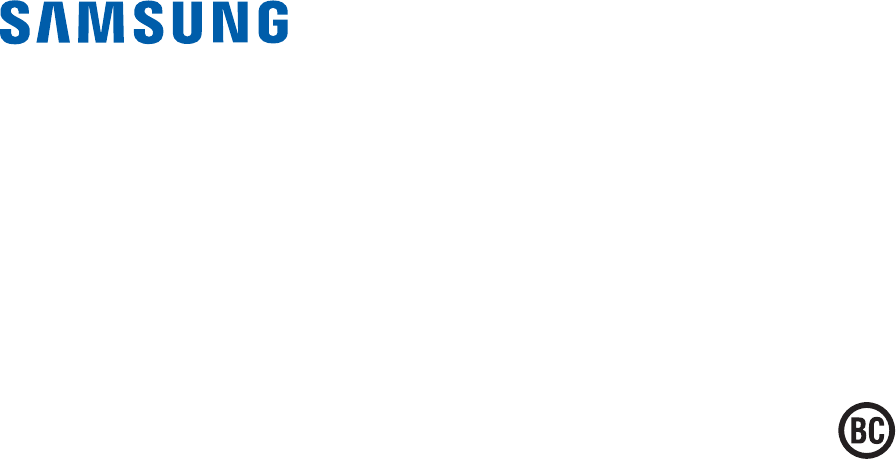
Some content may differ from the computer depending on the region, service provider, software version, or computer model, and is
subject to change without prior notice.
English. 10/2016 Rev. 1.0www.samsung.com